This post has not been edited by the GamesBeat staff. Opinions by GamesBeat community writers do not necessarily reflect those of the staff.
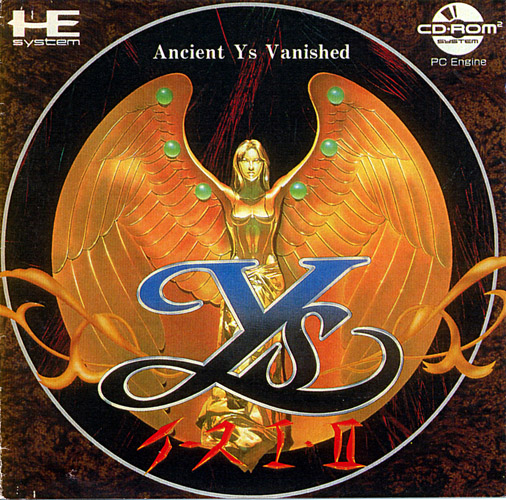
Ys III: Wanderers from Ys (Ys is pronounced like “ease”) on the SNES was my first exposure to Falcom's action RPG series. At the time, I thought it was just a quirky, side-scroller with cool music, neat visual effects, and punishing difficulty. Dying within seconds of entering the first “dungeon” was my first taste of humble pie with Falcom's arcade RPG series, a craving that had never really gone away.
Since then, I've kept in touch with the series via its North American releases here which, in exploring Falcom's history with the series, meant that I've missed out on a lot. Not only because I didn't have a TG-16 at the time, but because most of Falcom's releases were meant only for the PC enthusiast and video game market over in Japan. Fortunately, especially thanks to explosive growth of the Internet, ordering a title from Falcom has made getting a hold of its titles much easier and my eagerness to learn more about the series was rekindled with The Oath in Felghana.
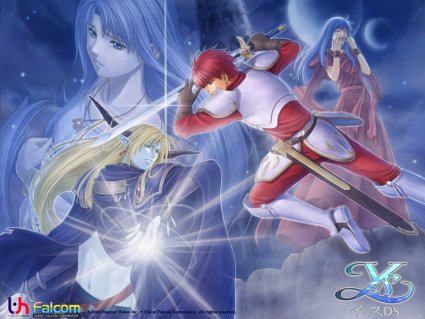
Adol the Red, Killer of Bosses
I had been wanting to write up something about Ys for awhile, if at least to shine a bit more light on this often misunderstood and overlooked series. At the very least, I consider it a way to sort through my own thoughts on the series and share what I've discovered from the truly hardcore fans that follow Falcom's work. The “short” can apply to the the fact that I haven't played every game listed here, so I've done my best to cover those titles with information gleaned from notes taken from other sources in my own journey to learn more about them..
If you're reading this, you're either a big fan of the series, someone curious about it, or someone who just wants to be sure that what I'm going to lay out in this short history is fairly accurate. I'm hoping you'll find something here that should make reading it worthwhile.
I would also like to especially thank Dan "Shoe" Hsu, Brian Shirk, and everyone at Bitmob that had very patiently helped me in making corrections and in proofing this article going forward. Without their incredible help and that of many others, this dedication to Ys wouldn't have been possible.
Who is Nihon Falcom?

Just another day at Falcom!
The English Wikipedia has scarce info on the the company other than it was founded in 1981 by Masayuki Kato and was a key player in the development of Japan's PC software industry. The most popular titles that they are probably most known for in North America are their Dragon Slayer and Ys titles but despite a long list of published works, they're still relatively unknown over here. In Japan, however, it's a decidedly different story.
Nihon Falcom (or simply Falcom) isn't a huge heavyweight like Square-Enix or Bioware in the West, but that doesn't mean that they haven't done pretty well for themselves in providing the kind of traditional fun that has earned them the adoration of many eager fans on both sides of the world. In an interview with RPGFan, Konami's Yoshinori Sasaki, the producer whose team had brought over YS VI – The Ark of Napishtim for the PS2, had been asked why they haven't moved to consoles and his answer indicated that because of their size, splitting their resources would have detracted from what they do best: appealing to their core fans.
And they've done pretty well in doing just that. While the graphics and the gameplay may look backwards in comparison to the sharpest CG proffered by many titles today, Falcom's devotion to what might be considered a “low-tech” approach has taken on a style of its own in much the same way that 8-bit chiptunes have earned their own place as a musical style. It might not have to appeal to everybody, but Falcom's core fans couldn't care less as long as the games are simply fun.
They're also a company firmly rooted in supporting PCs. Most, if not all, of their games have had their start on PCs and were only later ported over to a number of consoles. This is something that has continued through to today with re-issues of certain titles for Vista and Windows 7, but surprisingly, they'll install just fine on Western PCs without much fuss. Of course, there's the language thing, but hard working fans have made that less of a hurdle with walkthroughs and even fan translation patches.
Today, Falcom continues to do what they always do…put out fun games focused on their fans and create some of the best music that you might have never heard. And they don't show any signs of stopping. After almost thirty years in the business, they're still doing what they do best.
The Music

Falcom's music is like a smorgasbord of awesome
Aside from the games, Falcom's Sound Team JDK is also another reason why the Ys series stands out. People have called it techno-pop, butt rock, and J-rock, but most everyone that has listened to the music Ys: The Oath in Felghana or witnessed the introduction to the TG-16 CD version of Ys I & II agree that Falcom knows how to make sweet love to your eardrums with just the right sounds. There literally is something for everyone within the thousands of tracks that they have for their games.
The Ys series hadn't always enjoyed this kind of musical accompaniment, especially early on when MIDI and the hardware restrictions placed upon their work by consoles would limit the range of what they could actually do. But they did the best with what they had and most the results are pretty decent depending on what you hear them on.
The number of remakes have also given the range of music that the series is known for a degree of redundancy as well as a few pieces that are so dramatically different in their presentation while retaining just enough of the original to cast them in a nostalgic light among fans.
When CDs exploded onto the scene in the mid to late nineties, however, the PC remakes of their earlier titles benefited from the increased space of the medium as well as the improving hardware. As some PC developers in the West sought to fuse Hollywood and games onto these plastic platters, Falcom apparently used the opportunity to improve on their previous work with a variety of changes…most especially with the music itself. Although not every release has seen an orchestrated re-imagining, Falcom's continuing pursuit of polish has led the series' fans into expecting the best with each new title.
Their work on the TG-16 CD versions of Ys I & II had demonstrated what they were capable of doing, but Nihom Falcom backed away from the North American market and had licensed a scarce number of their games for others to bring out here. Ys III would be the last Ys title to see an official release on this side of the world, although their musical work would be made more readily available with an incredible number of collections, compilations, and “perfect” score arrangements.
Japanese releases of game music isn't as new a phenomenon in the West as EA's relatively recent foray into the same is. Similar to what their entertainment industry has done with anime, their games have often enjoyed a broader set of options for fans to immerse themselves within each title and Falcom's Ys collection is no different.
It wouldn't be until Ys VI: The Ark of the Napishtim for the PS2 that many in the West would get another taste of the legendary series and its music.
To renumerate the number of Ys collections, past and present, would require an article of its own. There's simply that much music out there that Falcom's hyperactive Sound Team JDK has put out for the series making every new game a cause for celebration and an omen for the number of OSTs to come.
The Games
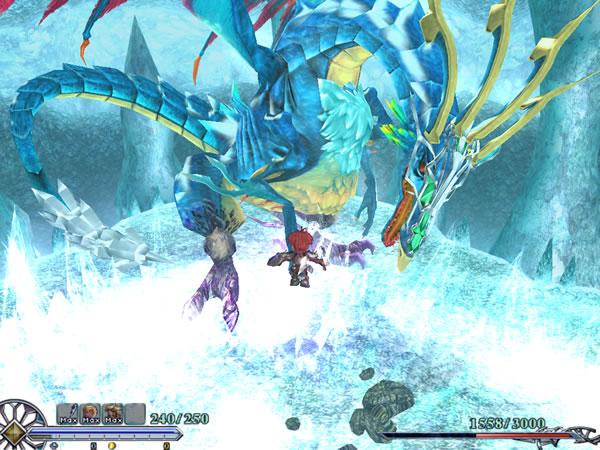
Humiliated by the same boss multiple times…Check!
The Ys series is one of Falcom's flagship franchises. After appearing first on the PC-8801 in Japan in 1987, the series has gone on to include seven major chapters, a number of title remakes, a strategy spinoff, a prequel, a hidden typing trainer, and an MMORPG. The series has also expanded into mobile offerings which are, unfortunately, Japan-only as most of their releases tend to be.
As mentioned before, not every Ys title made it over here. However, thanks to the Internet, their availability has become less of an issue by enabling fans to order directly from Falcom. It has also opened the door to emulation which has become the only option for some to even hope to experience what they have lost out on from Ys' console era despite its very grey legality.
Despite that, a number of fansub efforts have helped to bridge the language barrier by supplying translation patches for certain titles. The obvious benefit is that English speaking fans can enjoy Ys in English, especially after ordering their copy from Falcom which only arrive in Japanese. For titles that don't, dedicated fans have provided walkthroughs to guide others through while still being able to enjoy the action packed gameplay.
Ys is also an arcade RPG series featuring a number of characters carried through most of its chapters, but the main focus has almost always been on Adol Christin or, as he's also known because of his hair, Adol the Red. This red haired, swashbuckling swordsman is an icon of the series not only because of his penchant for finding adventure everywhere he goes, but because players see the world through his third-person eyes. Although each adventure can be played without having gone through any of the others, they all tie into each other to varying degrees as a part of one, contiguous world.
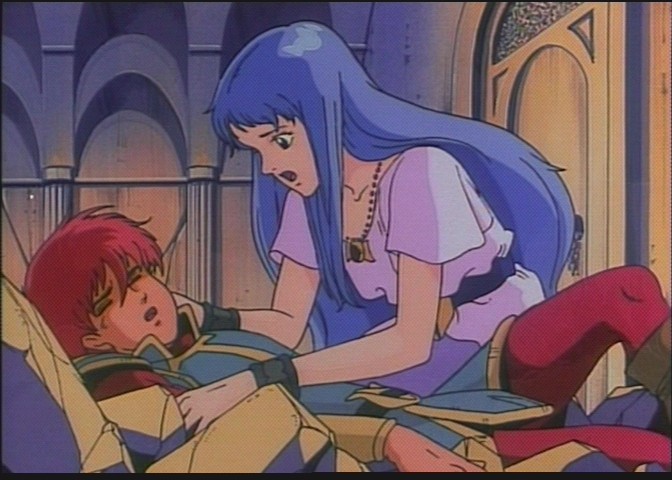
Adol, not quite at his best in the anime based on Ys I & II
Adol's world also draws a few parallels to our own with certain names. For example, the Romun Empire is a play off of the Roman Empire, but they don't look like Romans at all aside from being one of the most powerful nations there, along with “Afroca” and "Europa". The series is a mix of anime-styled swords and sorcery and many plots revolve around a distant past with the ruins of super-civilizations casting long shadows waiting to swallow up those greedy enough to awaken their secrets again.
They're also action heavy arcade-style slashers with just enough RPG aspects to them to keep them in the genre. Characters level up, buy new items, fight monsters, and even use materials to improve armor and weapons in certain titles. There's also a very specific formula to each one in that it's possible to push as far as you think you can go before encountering monsters so powerful that they would use Adol's head as a cue ball. The later titles don't fence in the player too much and let the critters do most of the work for them instead. There's clearly a basic strategy in getting through each one.
But it's the bosses that will likely test your patience. Some bosses are easy to figure out, others can make grown men weep before reaching for that walkthrough or in seeing how it's done on Youtube. And in its simple way, just leveling up is usually the answer to surviving long enough to take them down.
They don't try to reinvent the genre or force anyone to rethink the paradigms they might have grown up with. But in their own stylish approach, they're addictingly simple, fun, and challenging adventures done in what has become Falcom's unique style.
Fansubs
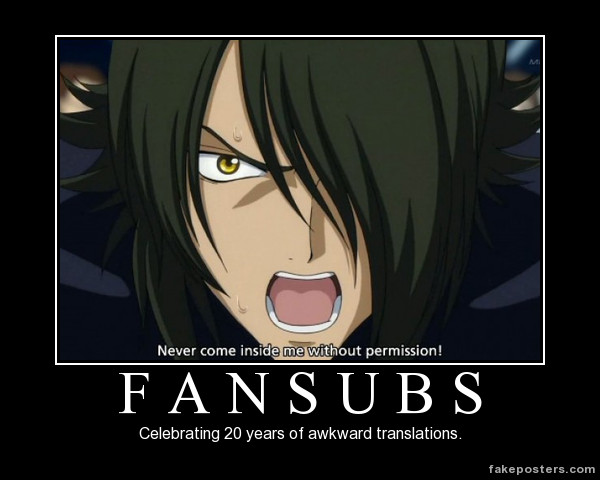
On one hand, here you are with a copy of Ys in hand but no way to enjoy the story outside of hearing someone translate it for you as you play. On the other, some fans have gone through the trouble of actually working through the game and have created a number of patches that do just that. This can also open the door to potential piracy. Why pay for the game when you can download both?
Fansubs in general have had a long history, one that goes beyond the scope of this article, stretching back through the early days of anime when it wasn't as readily available as it is now. It has also been mired in as much controversy and has created its own set of unspoken rules among each group that largely persists today. That it also tends to violate international copyright laws is also a big part of the debate.
At the same time, fans counter that they aren't trying to make a buck off of their work and are purely doing it out of the passion they have for their hobby. If anything, their efforts have helped to bring more attention to the series they take on, something that big names such as Kadokawa have acknowledged overseas (while at the same time, enforcing their copyrights with cease-and-desist warnings for other properties). Even the community is split between “white” and “black hat” translation groups: those that respectfully stop when a company licenses the distribution of a certain series, while others continue on regardless.
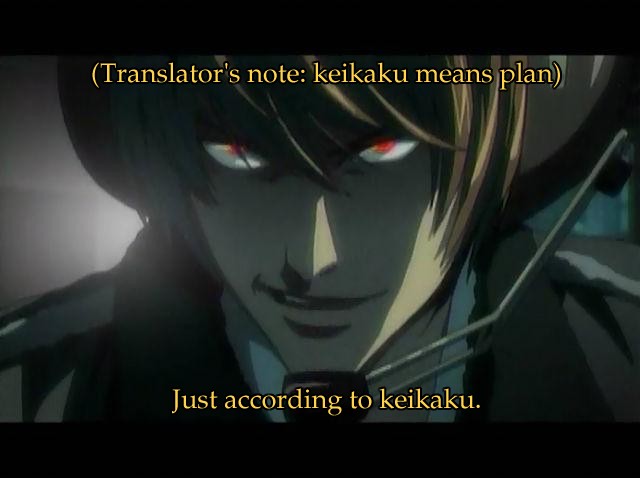
Fortunately, fansubs (and official localizations) are of a much higher quality today. For the most part.
On the other side of the coin, fansubs for anime and untranslated games have earned tacit, if not outright, approval from unexpected quarters. Professional translator, Clyde Mandelin, loaned his talents to translating Mother 3 and had even received support in the form of encouragement from e-mails sent over from Square-Enix. Nintendo's Reggie Fils-Aime even knew of the project. Clyde and the group he was working with were fully prepared to drop everything if Nintendo had decided to step in and stop the show, but it didn't happen and fans got to enjoy a rare classic that they had been waiting years to play.
Most of the Ys series, particular the PC versions, have been translated by fans and their patches are out there if you do a little digging. Ys: Typing of Ys is even offered as a translated piece of freeware, although that isn't typical.
To avoid getting Bitmob into any potential trouble, that's why you won't find direct links to subtitles in this particular article. At the same time, however, my hat's off to all of the hardworking fans, publishers, developers, and programmers that have made it possible to enjoy Ys over the years. Thanks to their efforts, they've helped to make fans over here.
Ancient Ys Vanished (Ys I and II)
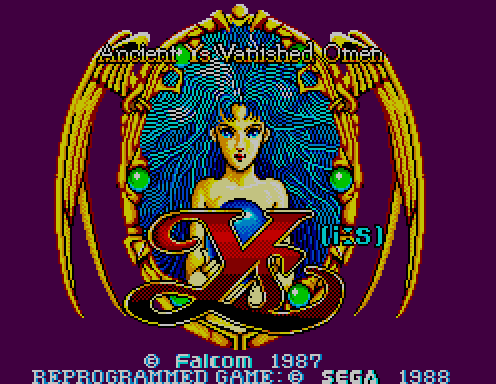
Ys I: Ancient Ys Vanished Omen on the Master System
When Nihon Falcom put together Ys I, they probably didn't know just how far Adol Christin's adventures would take him and everyone that followed them.
Both Ys I & II introduced us to Adol the Red, otherwise known as Adol Christin; the always-in-trouble protagonist that would survive countless adventures, gigantic bosses, and dark dungeons from one end of his world to the next.
As Atlus recounts his history in Legacy of Ys' manual, as a child, he hears the story of Ys, a legendary kingdom renowned for the prosperity of its people, the wisdom of its six priests, and the benevolence of the twin goddesses that watched over it. But, a great cataclysm strikes the fantastic civilization, the nature of which had been lost to time, and Ys disappeared into legend. It would inspire the young man to travel the world and at the age of 16, he set out to discover for himself if there were any truth to the stories.
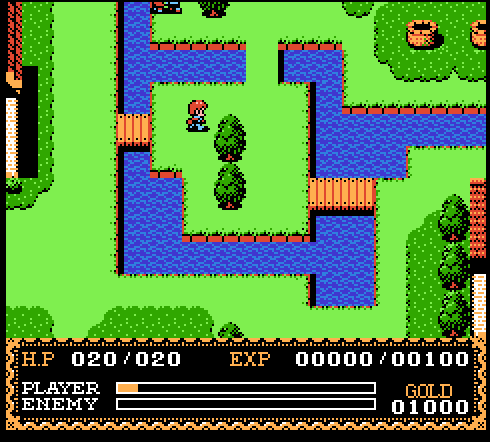
Ys I: Ancient Ys Vanished Omen NES screen
During one of these travels, he overhears the the story of Esteria, an island renowned for its silver exports that had suddenly become cut off from the mainland thanks to a mysterious storm. Curious to see the island for himself, he would brave the rough seas only to wash up on Esteria's shores barely alive…but no less ready to take on his first real adventure.
Ys I covers the first half of the story to the game and Ys II finishes it, although both were initially released almost a year apart. Ys I also focused more on combat while Ys II would introduce the first elements of the magic system that would become part of the series which would also go through as many tweaks as its base gameplay. It also felt much larger than the first game which comes off as more of a warm up to what this would bring to the table.
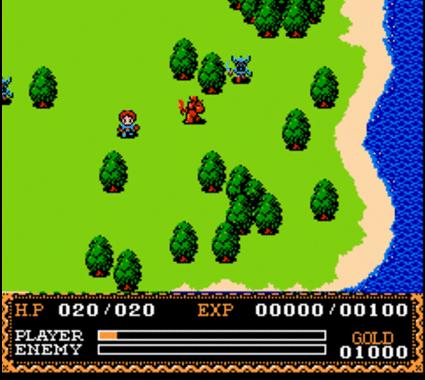
Ys I (Wii Virtual Console port)
The game is played from a top down perspective and the basic interface required the player only to bump into enemies in order to attack them. Unlike its closest contemprorary on the Famicom (the NES in the West), Nintendo's Legend of Zelda, players didn't need to actually "use" a sword to beat enemies with because of the demolition derby that Adol would play with his enemies instead.
Was it weird? For me, yes it was. It felt counterintuitive to feel like a linebacker or a hockey player in having to check my enemies when being like Errol Flynn made more sense especially after playing the series' later titles. But, after tinkering with it for a bit more, it grew on me. In its own strange way, it worked better than I had first thought it would.
There was no button to press to swing a sword or stomp on foes. Though it sounds easy, there's actually some strategy involved – hitting enemies head on was a sure way to get killed quickly early in the game. Maneuvering behind foes or “bumping” them from the sides or from angles would yield the best results. Against bosses using unique attack styles, jousting in between thrown bolts of magic for that hit and then running back out again required a steady set of fingers and a decent amount of patience.
Adol did have regenerating health outside of dungeons while standing still, although he could rely on items to restore it when he was in an area that restricted it such as during a boss fight. Even then, he was extremely limited by how many of each item he could actually carry. Magic introduced with Ys II and added a new dimension to his attacks, especially in dealing with the bosses in the game. As for the music, the legendary Yuzo Koshiro's talents would be responsible for the original tracks that would later be embellished and improved with their remakes.
The first game in the series debuted in 1987 on NEC's PC-8801 (more commonly known as the PC-88) in Japan and was ported to a variety of systems including the Sega Master System which would also lead to a North American release, giant clamshell case and all.
It's sequel would come out a year later, although it would grace the North America as part of the Ys I & II compilation for the TG-16 CD in 1990 which, thanks to the new medium, features a bombastic introductory sequence with enhanced music…music which was actually not arranged by Yuzo Koshiro, but by Ryo Yonemitsu who is himself a legend. According to Sega-16, it has been Falcom's practice to credit the sound programmers versus the composers, so as a result, it's listed as the work of Falcom Sound Team JDK.
Since the first game's debut in 1987, both would lend themselves to what will later become a Nihon Falcom tradition with the series: the remake. And not just one remake. Both of these would become part and parcel to multi-remakes over the next twenty or so years. Obsessive perfectionists? Or simply fanservice taken to another level?
As the hardware improved, so did the production values. In 1998, Ys Eternal, a remake of Ys I, was released in Japan for PCs and took advantage of the hardware with sharper graphics, a greater palette of colors, better music, and a lavish introductory sequence. Although the core gameplay remained the same along with the number of dungeons, the presentation gave the series a major facelift. In 2000, Ys II would be released as Ys II Eternal with the same changes.
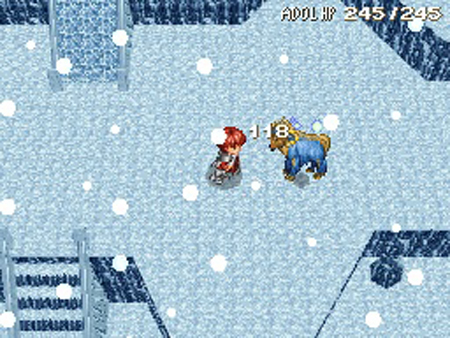
Legacy of Ys: Book II on the Nintendo DS
Both games would again be re-released as Ys I & II Complete for Japanese PCs in 2001 with a few more visual tweaks such as brightening touches to the anime artwork for each character, more details added to the store graphics, and a few more enhancements turning it into what some might call the definitive remake of both games. It should also be noted that anime director, Makoto Shinkai, had also been working with Falcom until 2000 and influences of his artistic style can be seen within the cinematic introductions created for the Eternal editions and carried over into the Complete compilation.
Ys Eternal Story, which is both Ys I and II, was based on the work done for the PC version of Complete and released only for the PS2 in Japan in 2001.
Later releases, such as the Legacy of Ys: Books I & II for the Nintendo DS and Ys I & II Chronicles for the PSP, would be largely based on the work applied to the PC Complete versions. However, according to Atlus, the Nintendo DS release of Legacy boasts a slightly expanded and revised story over that found in the TG-16 release.
The use of the DS' stylus was also added in, although I wished that you could use the D-pad instead to steer Adol around. You can, but in doing so, you have to get Adol to manually attack his enemies with a little button mashing which is ironic for a mode that calls itself "Normal". It's understandable at this point why this mode was offered: Atlus didn't want to frustrate newcomers to the series that might not quite "get" the original method.
The other mode, which uses the stylus, is much closer to the original's bump combat as you used it to drag Adol into his foes. It wasn't perfect and could be a bit cumbersome to deal with, but it managed to get the job done. It would have been nice if the D-pad could have been used instead, but at least Atlus' port had wisely kept the bump combat an option instead of removing it entirely because of a fear that it might alienate players.
Additional links:
- Jeff Davis, Gaming Intelligence Agency's Ys I & II Retrospective (mirror)
-
Official Atlus site for Legacy of Ys Books I & II
Legacy of Ys: Book I on the Nintendo DS
Ys II Special
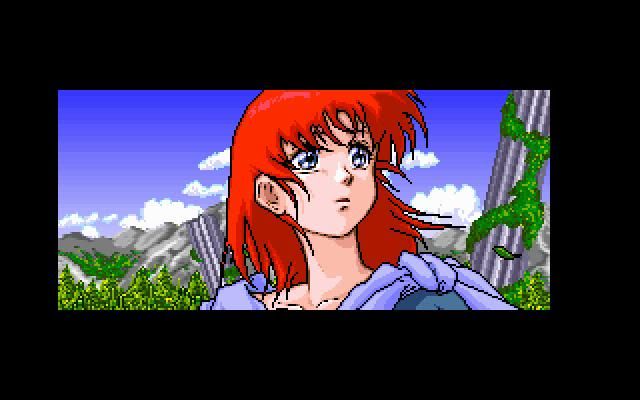
A shot from the introduction to the game when it started working.
I had never heard about this one until I started this project and discovered that a fan had uncovered an “Oath in Felghana” scale makeover that had happened once before in 1994 with Ys II. If it was that good, I had to find out more.
According to the page created by a poster on Ancient Land of Ys who calls himself Seldane, the remake project had started in 1992. According to Seldane's information, a South Korean company named MANTRA licensed the game from Nihom Falcom and took it upon themselves to remake and release this new Ys II and had worked to expand many of its features making it a much larger, and longer, game. They had even contracted their own band, soundTEmP, to fill in for Falcom's Sound Team JDK.
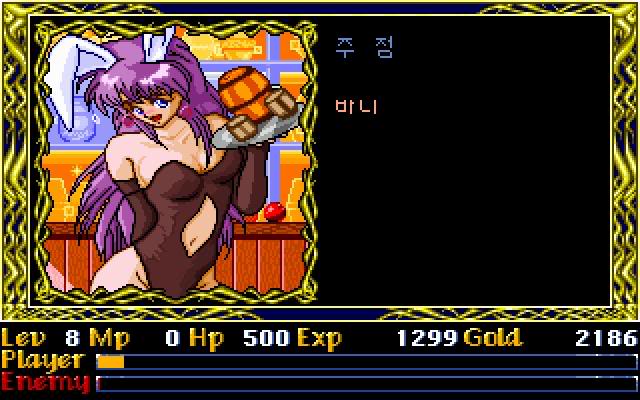
A bunny girl in a Japanese game ported by South Korea? Is anyone really surprised?
It was also apparently very buggy with patches that introduced only more bugs into the mix.
My first experimentation with it wasn't too impressive. After finding a copy, I tried it out in DOSBox. Initially, the intro – hinting at what could have been great – ran at a snail's pace. Figuring out how to get the music to even start was something of a small challenge once I ran the install configuration.
The controls are a little finicky and through trial and error, I found out that the ALT key acts as the confirmation button, and CTRL backs through conversations or out of menus. The F1 – F4 keys bring up the menus for the game such as the loading screen for saves, Adol's status (which is actually in English along with most of the basic interface), inventory, and equipment. Hitting TAB brings up a smaller menu displaying the others as a list.
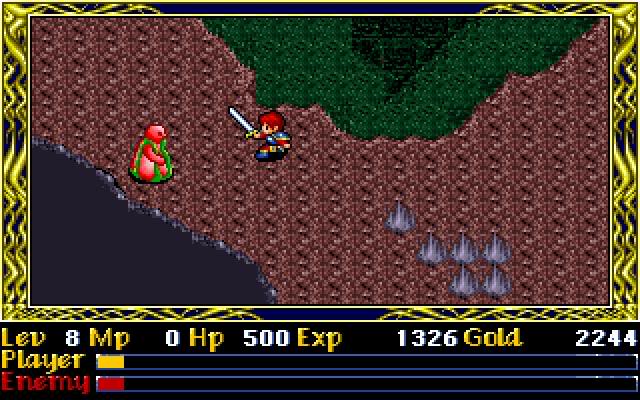
It looks like this monster moves with its own vomit. Maybe it's on Spring Break.
Arrow keys move Adol around when he's not in a menu or talking to anyone and the ALT key swings his sword. You can still bump into enemies, but swinging Adol's blade seems to work much better. Other alterations to the original Ys II game include a somewhat different leveling scheme. Though Adol's maximum HP has traditionally been 255, reaching level 8 brought his HP to 500. Stronger creatures do damage consummate with the changes, however, so it's not as dramatic a change as it might seem at first.
Unlike Falcom's own titles, it's also not very subtle as to where the player should and shouldn't go. Monsters that can't even be scratched by my weapon were obviously there to tell me “Don't go here” in as much as the hangul text boxes that came up when I wandered too far off the beaten path. Dying from a single touch or from poison (or was it a bug?) that drained my hundreds of HP was also as fun.
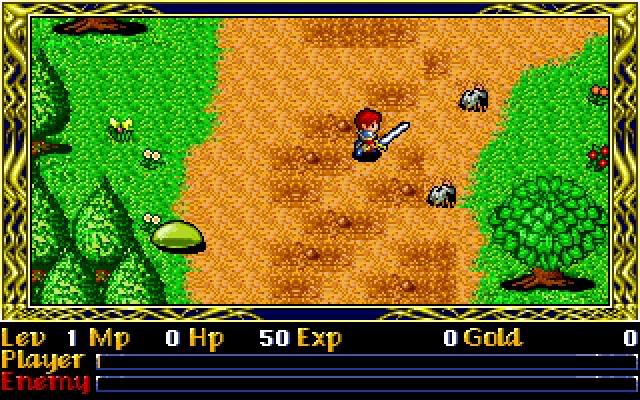 Adol runs along a dirt road while a slime chortles menacingly behind him. Well, not really, but slimes can really mess you up early on in this game.
Adol runs along a dirt road while a slime chortles menacingly behind him. Well, not really, but slimes can really mess you up early on in this game.
Under DOSBox 0.72 (and a reboot), the game suddenly ran pretty smoothly. The music stuttered on occasion and performance seemed to drop slightly when there was more activity onscreen, but otherwise, it wasn't too bad. It even had an animated intro and the scene where Lillia turns to face the screen is still a beautiful piece of work and seems directly copied from the anime frame by frame.
One glitch I noticed included a visit to the Inn where Adol's gold and HP displayed on the bottom of the screen “glitch” to lower levels until you leave and everything is normal again. SoundTEmP's soundtrack comes off as a very good rendition of what Sound Team JDK is known for with a little personal embellishment.
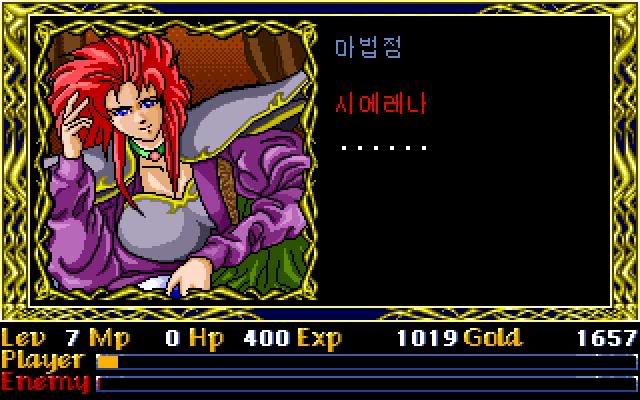
No, it's not David Bowie from Labyrinth.
Character portraits had also undergone a bit of change and look different from the ones that Falcom had done for its own Ys II revival. As in, incredibly different.
However, Seldane's article also points to its inherent quality and the passion that made it an extremely unique Ys title and remake within the series' history. Back then, the Internet wasn't as popular as it is today so losing out on this piece of franchise history might have been as permanent as seeing those Spring Break pictures that you never wanted on the web come up years later. Thanks to the same passion for the series that the developers had in making it, however, it has managed to live on…if not run well.
Additional links:
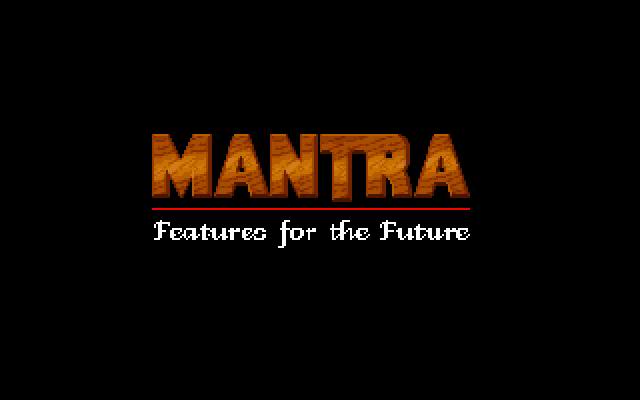
Sadly, the company that made the game is long gone.
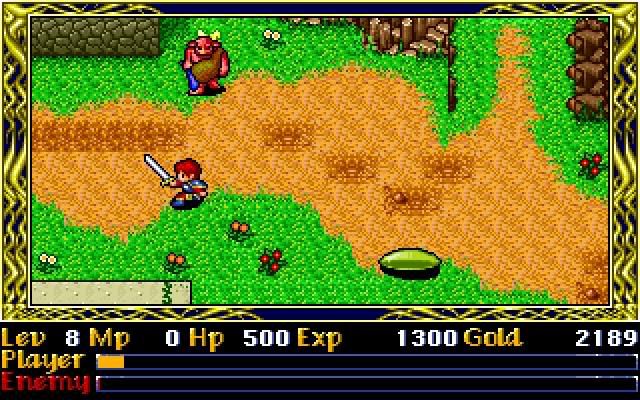
Ys III: Wanderers from Ys
“And the warrior…is you!”
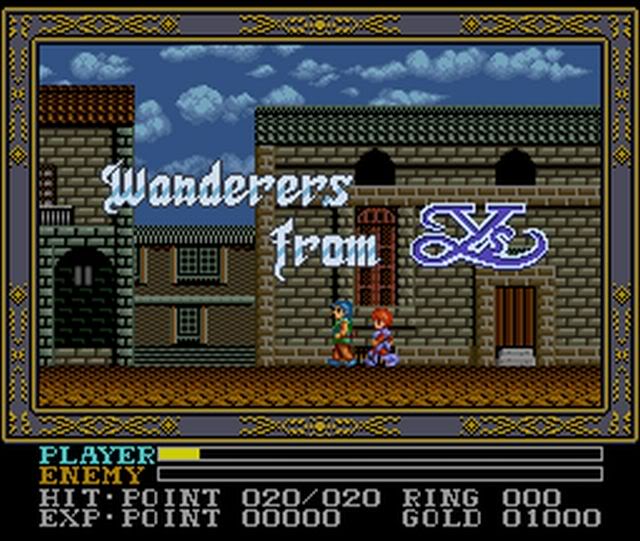
This is where it started for me on the SNES
Ys III would first debut on the PC-88 in Japan, but little would those in the West know that it would also be the last taste they would have of the series outside of imports.
It would be ported over to the popular TG-16 continuing Falcom's association with NEC, the Sega Genesis, and the SNES which were busy waging a three way war for 16-bit domination of the marketplace when it arrived in 1991.

Sega 16's comparison screens between each release
All three versions would also have dramatically different opening sequences, although the gameplay and story remained relatively the same. The biggest differences would belong to the TG-16's intro thanks to the bleeding edge technology of CDs. After all, what game could possibly use more than one…oh, right.
Now, Galbalan was the name of the main villain in both the Genesis and SNES versions. I couldn't forget that name thanks to nearly throwing a controller out of the window when he would repeatedly use Adol as a beam target. Thanks!
But for some reason, he would be introduced as Demonicus in the TG-16 version. Adol would also be presented as a stylized, bronze skinned and golden haired Spartan during the narrated intro.
When the actual game started, the player was suddenly cast as a red-headed adventurer ready to sail across the seas (Adol and boats..). But the animated intro was decent on a technical level, if not misleading, in making use of the TG-16's CD format. Dude…it talks!
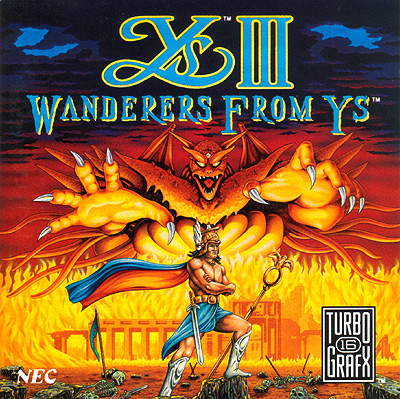
Game cover for the TG-16 version. Whoever did the art may have thought that was Adol, but he wasn't.
It's also not the first time something didn't quite mesh with what was seen and what was actually in the game. Localization issues were also much more prevalent in those days, especially in between different licensees. Who could forget Michael Biehn on the cover of Metal Gear as Snake?
The story begins three years following the events from Ys II. After all, Adol and Dogi had helped to save the world, so who knows what they did in the years they had since that time to match it. At least they didn't pull a Ghostbusters 2.
But Dogi gets homesick and decides to return home. The bad news is that Adol's habit for finding trouble drags some of that bad karma along when things turn out to be not quite as peaceful as his friend remembers them. Evil things are afoot, so naturally, our red-headed swordsman heads out to kick more ass. And while he did have something to say in the first two Ys, it continues here with the slowly rarified event where Adol actually says something other than "Adol explains X".
The biggest change for longtime fans, however, is in what they saw when the game began.
For whatever reason, Falcom threw out the top down view that it used for Ys I and II and instead went the side-scrolling route similar to Castlevania II: Simon's Quest with player initiated attacks. Collecting different rings for different magical powers would return and the difficulty was still there despite the change in perspective and the use of parallax scrolling.
Adol had also become the Bruce Lee of sword speed in the three years since his last adventure: hitting or holding down the attack button would turn his blade into a swinging curtain of steel. It didn't make him invincible, but it was probably a good thing that the designers opted not to put in a stamina bar.
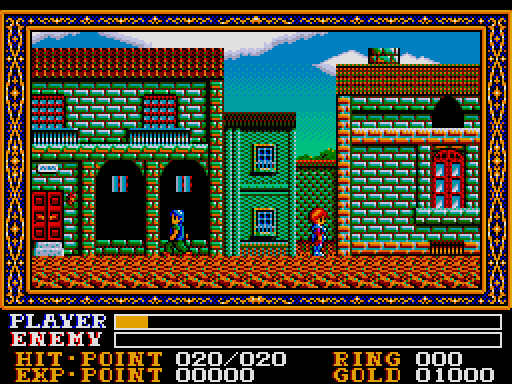
Ys III on the MSX2
I remember getting my ass handed to me several times in this game, even with the regenerating health system, and didn't know that this wasn't what the previous Ys games were like. To me, the music, monsters, and the grinding were pretty addicting staples to play with until I reached the level cap. Adol's fast swordplay, regenerating monster spawns, and easy controls didn't make the trudging journey to the next level as tedious as it could have been.
And there was still something alluring about the game, whether it was the music or the cool tower effect while climbing up to meet the evil Galbalan for the final battle. Hated that boss. Little did I know that he'd become much worse in the remake.
Ys III eventually underwent an almost customary facelift that Falcom's titles are known for and be released again on the PS2 in 2005. It would retain the side-scrolling action of the original, but with better graphics, updated score, and voice acting all around. Adol and Dogi also have speaking parts, so if you're curious to know what they sound like in Japanese and have a Japanese PS2 (or one modded to read imported discs), here you go.
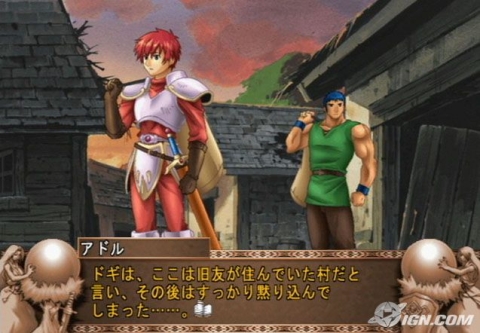
Adol talking? Yes, it's true.
As to whether Taito's remake is actually worth a look, judging from this review, it's not much of an improvement other than with its presentation. It wouldn't be until 2005 that Falcom would introduce its own idea on what a remake should be like and blow fans away with The Oath in Felghana.
Additional links:
Media:
[embed:http://www.youtube.com/watch?v=rMz1GQlY4ng ]
[embed:http://www.youtube.com/watch?v=0Y_Q2vn-SyM ]
[embed:http://www.youtube.com/watch?v=rMz1GQlY4ng ]
Ys IV: Mask of the Sun / Ys IV: Dawn of Ys / Ys: Mask of the Sun – A New Theory

Ys IV: Mask of the Sun title for the Super Famicom
There's a strange story attached to these Japan-only releases
One thing that you should know about Falcom, if you haven't guessed by what had happened with Ys III, is that they'd sometimes license an outside developer to create the game around the scenario they had designed. It would be as if Square-Enix had come up with the scenario for the next Final Fantasy, but licensed Bioware to handle the actual development for it. The results can be hit or miss depending on who is putting the game together, but the scenario can also tend to play out somewhat differently as Tonkin House and Hudson Soft had demonstrated with Ys IV.
Who is Tonkin House? I'm not sure myself. There's not a lot of information on just what they do, other than that they work with PC software, edutainment, and are something of a game developer. They were also responsible for Mask of the Sun which came out for the SNES (Super Famicom in Japan) in 1993.
Hudson Soft, of Bomberman and Bonk fame, was responsible for Dawn of Ys which came out for the TG-16 (PC Engine in Japan), also in 1993. They were a company I knew, so I only guessed that their version of Ys IV would be the one that fans would appreciate most if only because they would at least know more about game development than the other guys. But as I found out, that wasn't quite the case.
In both scenarios, it's been two years since the events of Ys II (and takes place before Ys III…confused yet?). Adol discovers a message in a bottle asking for help from someone in the land of Celceta and never one to turn down a request, sets off to find who sent it and why. After being thrown in prison by the Romun Empire after escorting a trader, he discovers that they also have designs on Celceta and hope to annex it with the help of three powerful mages.
Although it looks like Mask is pretty much accepted as part of the canon, a poster on Ancient Land of Ys' forums had pointed out that the Japanese Wikipedia on the subject that Dawn had at one point been considered as part of the main scenario until later when Mask of the Sun was given the honors. But it hasn't stopped a lively, but friendly debate among fans as to which version they prefer for their own reasons.
Dawn's exemplary music, voiced characters, extended ending, and visual look takes advantage of the PC Engine's CD format with quite a bit of extra content that Hudson Soft took liberties with. Others prefer Mask of the Sun's closer tie to Falcom's vision and to the anime OVA based on the series.
But both games returned to the “bump combat” of the first two, tossing away the side-scrolling action of Ys III (but providing little explanation for why Adol became the fastest swordsman in the land later on). While I didn't mind the side-scrolling action of Ys III, I wasn't too put off by the return of bump combat once I got the hang of it again.
The usual menagerie of wicked bosses, powerful magic, regenerating HP outside of dungeons, and legions of nasty monsters are mixed in with the large dungeons and expansive story. From when you hit the town of Promarock to exploring the maze of Iris Tower, the soundtrack also keeps pace with the action with several memorable pieces.
One thing that was interesting about Ys IV: Mask of the Sun is that it also features one of the increasingly rare moments when Adol actually has something to say on his own, notably towards the end when he takes a leap of faith. Or when he and one of the head bad guys have a verbal showdown revealing all before the main event.

Ys IV: Mask of the Sun – A New Theory – for the PS2
Taito's licensed remake of Ys IV is similar to that which they did with Ys III incorporating an isometric, third-person look centered on Adol and speaking parts for its characters. As to whether it is actually solid enough to earn fans' respect, reactions have been less than enthusiastic from what I've been able to gather.
Media:
[embed:http://www.youtube.com/watch?v=-Tx66ciM8z8 ]
Ys IV Mask of the Sun – A New Theory – (PS2)
Ys V: Lost Kefin, Kingdom of Sand / Ys V Expert
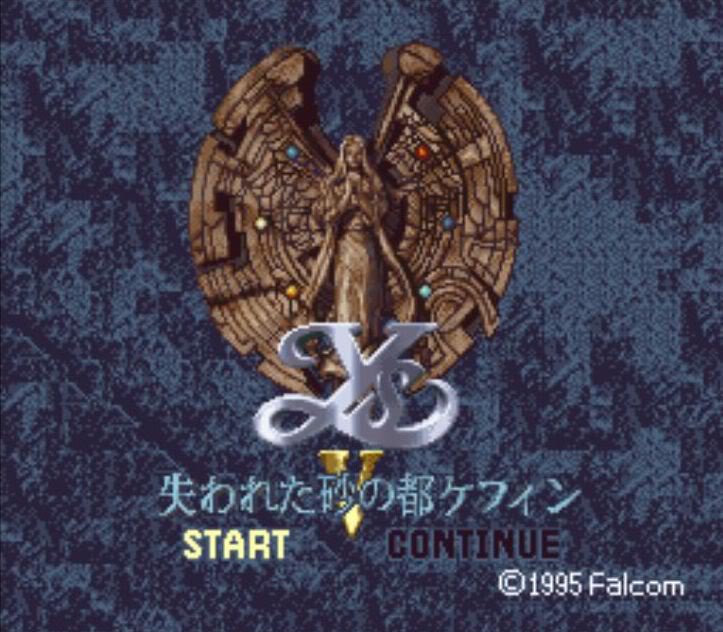
Ys V Title Screen for the Super Famicom
In 1995, Falcom released Ys V on the Super Famicom and looking at it, it was easy to mistake it as any other 16-bit RPG for the console.
Square's Final Fantasy VI (III in the States) had just come out in '94, and Chrono Trigger had also come out in March of '95. 16-bit RPGs on the SNES had a distinct look to them, no doubt helped by the popularity of two of Square's biggest titles. Secret of Mana had also been released two years prior to Ys V in '93.
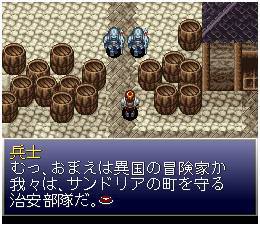
Adol faces a very unwelcome greeting.
It would, however, act as a precursor to the gameplay mechanics that would return with Ys VI: The Ark of Napishtim. The top down action was back, but “bump combat” would never return.
Players now had to use a button to attack and defend with Adol's shield, similar to the system used in Ys III, but not quite as fast. Adol could also jump up to onto ledges and regenerating health was still a staple as long as he could stand still without getting killed. It was a different approach, but one that would eventually become wildly popular…after quite a bit of polish, such as dropping the need to actually 'use' the shield.
Saying that the system was a little rough is also a matter of how much you either like or hate its gameplay after trying it.
In taking Adol out to grind up outside the first town, slash combat felt slower in comparison to the fighting speed inherent within Ys III and the no-nonsense bumping of Ys IV: Mask of the Sun. But it had one or two things going for it.
Targeting for sword strikes in Ys V felt more deliberate – you have to aim your shots more at the enemy – requiring a little tactical maneuvering as its bump combat had necessitated to get the best angles. It also featured an interesting experience mechanic split between your melee weapon and magic, that the skill you used more often would earn points and eventually improve.
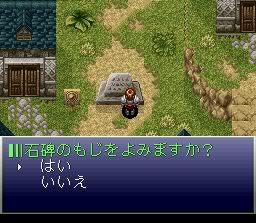
Adol faces a new mystery
But when taken in comparison to a title such as Secret of Mana whose own sword-based combat felt as if it opened more doors than restricted you into a particular system, it felt as if it was much easier on the player in dealing with. It was also quick. had the benefit of multiple weapons, party members, and a rudimentary AI behavior system to guide their actions. And that was two years before Ys V came onto the scene.
The magic system, once you get it at a certain point in the story, wasn't that fun. Adol can equip magic and to use it, the player has to hold down the R button to charge it up and then can unleash it with the attack button. After doing so, the charge starts to deplete unless you hold down the R button again to cast it again. It's useful as a ranged option to have, but in terms of damage, it's not all that impressive once you arm Adol with decent equipment.
There is also a trading system that was developed for the game. Enemies will drop different types of gemstones that you can trade for cash at different towns and villages and not everyone offers the same rates, leaving it to the player to run about and gobble up gems from killing monsters and then locating their favorite trader.
From a technical perspective, Ys V could appear to be behind the times and still could be fun if you stuck with it, but it was clearly out of its league against similar peers on the SNES if you decided to compare it from that perspective. And it was, as other fans have pointed out, far easier to play through with bosses that didn't quite prove as controller-smashingly hard as the least of Ys' earlier terrors. But at least the music was nice to listen to. The bar music at the start of the game isn't bad and the port tune sounds reminiscent of Nobuo Uematsu's work with Final Fantasy.
Storywise, I'm not too sure myself what was going on since there was no English translation, official or fansubbed, made available for it, although the initial scrolling text is in English to provide a little background. From what else I've been able to scrape together from other sources on the 'net, Adol finds himself on the continent of Afroca where he's drawn into a plot concerning the long lost city of Kefin. Others are busy seeking its ancient legacy as well and Adol eventually finds himself not only fighting the ancient things that still lurk beneath the sands, but the forces that seek Kefin's secrets which apparently include a 500 year old spirit and a girl shut inside a giant crystal.
But one thing that was clear was that fans were unhappy with it. The weak difficulty was one factor and a surprising turn for a series often known for its ruthless bosses. Falcom then released a tougher version of the same game, Ys V Expert, a mere few months later in '96. It's amazing to think that because the game had met with such a harsh reception from fans that Falcom would re-issue the same game with only a slightly higher difficulty, and this was when cartridges were still in vogue in the pre-DLC era for consoles.
Nothing else was really changed other than the fact that monsters hit far harder than they did before, but was it worth buying what was basically the same game twice? I can only guess that some thought it was worth it enough to do so because Falcom is still around.
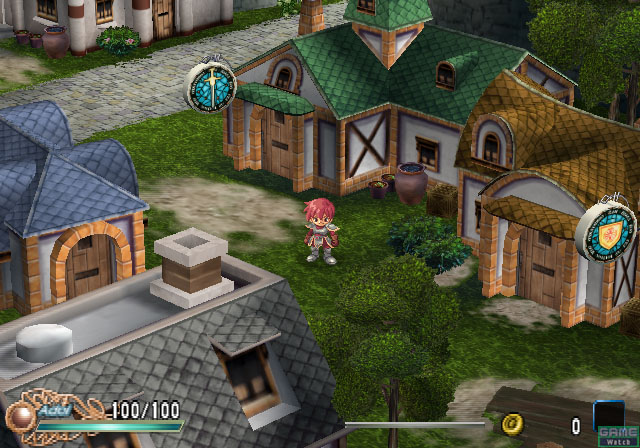
Ys V for the PS2
Taito would release a PS2 version of the game in 2006 with an entirely new opening, updated graphics, and voice actors. Gameplay resembles that of Ys VI (which came out in 2003) with an isometric, third person view centered on Adol's super-deformed sprite. It doesn't look too bad, but then again, looks can be deceiving.
It's still an Ys title and it's not horribly done (depending on which version you play), but it doesn't quite stand out as much as it could have, either, after seeing what Falcom had treated its fans to before.
Additional links:
Media:
[embed:http://www.youtube.com/watch?v=5QJH441bbmw ]
[embed:http://www.youtube.com/watch?v=1rzybMq8vCQ ]
[embed:http://www.youtube.com/watch?v=y4E3dRGzYec&feature=related ]
[embed:http://www.youtube.com/watch?v=l3shiIRVPC0 ]
[embed:http://www.youtube.com/watch?v=EoMoNZE2DnM ]
Ys VI: The Ark of Napishtim
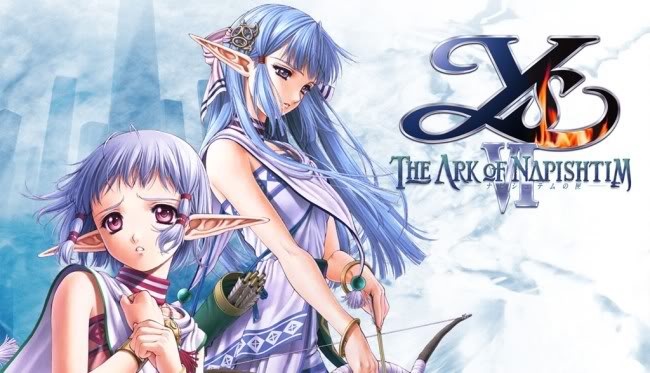
Falcom's focus with the Ys series would return to the PC platform in 2003 with Ys VI. It initially came out as a Limited Edition which also came packed with emulated versions of Ys I – V making it an incredible treat for Ys fans…at least on the PC. After that sold out, a “Normal” version was released with additional enhancements such as new difficulty levels and a boss rush mode.
It was a Japan-only release until 2005 when Konami unexpectedly released a port for the PS2 to Western audiences with several enhancements such as CG movies, full voice acting, and additional gameplay in the form of optional action-based puzzles called Alma's Trials. Doing the Trials was a good thing, however, since they often rewarded the player with goodies. Goodies that were good for monster cutting upgrades.
It would come back on the PSP in 2006, again only for Japan, and see a re-release for Vista in 2007. Even though a PS2 release was on hand with an official translation from Konami, hardcore Ys fans weren't satisfied and had released an English patch for the 2003 PC version of the game, updating it for Vista when that came out. Now that's dedication.
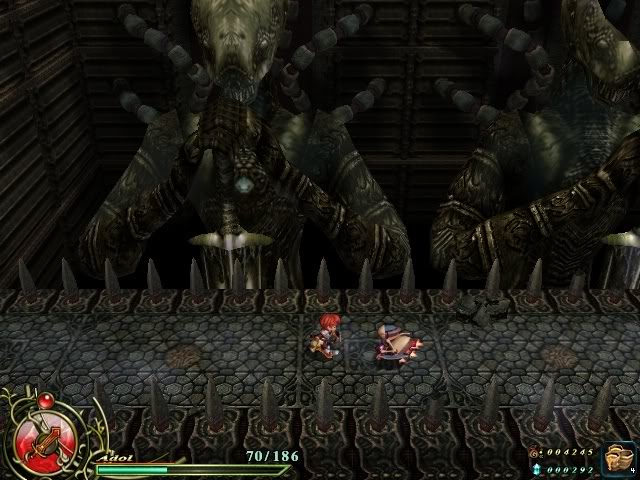
Adol is about to score a few more XP (PC screenshot)
In this adventure, Adol joins up with Ladoc the Pirate and survives another near-drowning experience. He washes up in the heart of the Vortex of Canaan on one of three islands after surviving yet another shipwreck, courtesy of the Romun Empire's cannons.
He soon becomes wrapped up in an adventure to uncover an ancient power before the nefarious Romuns can lay their hands on it, but to succeed, he'll need to unravel Canaan's mysteries which will involve another bout of population decline among the monster community. There is a slight difference, however, with how it plays out between the PC and PS2 versions of the game (and between the PS2 and PSP versions where Alma's Trials were concerned), but Falcom had OK'd the change when Konami did their ports.
Ark took the gameplay mechanics of Ys V while adding in the quickness of III and polished the formula's flow to be much faster and more engaging with its action. Also gone was the "charging and fusion" magic system from Ys V with simple-to-use magic rings making a comeback. Saves, though, have to be made at specific points in the game as opposed to bringing up the menu and saving where you were which was a nice luxury to have in the earlier Ys titles.
Even the menus returned to their more traditional format with equipment laid out in categorical rows. Throw in the tough bosses that fans love and hate, and you've got an Ys title that does its best to try and get back to the basics.
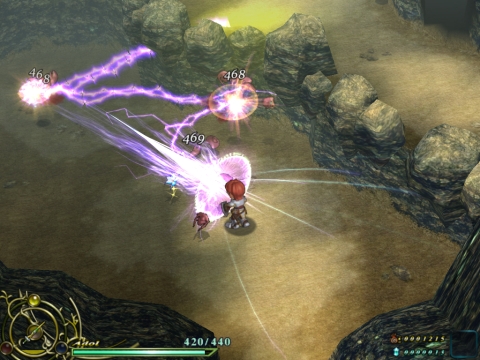
Adol opens a can of electrified death, deep frying everything in his path (PC screenshot)
Without the limitations of a cartridge-based format and by returning to their roots on the PC, Falcom once again flexed their creativity with strong presentation values. 3D graphics were used to flesh out the environment, hi-res anime artwork was used for character portraits along with the story's cinematic cuts, and the music hit many of the right notes.
For the PS2 release, Konami decided to voice each character and while that was a big thing by itself, the actual quality was…not as good. Adol's on and off again acting sees him return to the series as a mute as the game summarizes what he actually explains along the lines of “Adol explains why he hates ships.” and then leaves it to the NPCs to tell the story. But since Adol is silent most of the time anyway, it's not that jarring.
The PC version also benefits from higher-res textures and details and the PS2 version, while decent, lacked much of that making some areas seem bland. 3D models were added into the PS2 version, a departure from the detailed sprites of the PC original and something of a downgrade in detail. As nice as it was to see Adol and most every other NPC rendered in polys, they didn't look that great.
More surprising were the CG cinematics. Before artists had managed to bridge the gap between anime and 3D, Ys VI had gone the other way with its cutscenes. In as much as bad cover art tried to fill in for the 8-bit characters' appearance, the cinematics in Ys VI tried doing the same thing for its anime-drawn characters with somewhat awful results.
It was like looking at the Westernized cover of the first Mega Man and wondering why you were suddenly playing as a stumpy, round headed guy with giant eyes, only going in the opposite direction. But Konami isn't wholly to blame for how those movies turned out as it was created for the game by an outside company, and it sounds like they simply included them despite not being entirely satisifed with how the models turned out. Perhaps in this case, it might have been better to leave these on the cutting room floor.

Size matters not. Fast reflexes do. (PS2 screenshot)
Ys also saw a re-release on the PSP thanks again to Konami and sported a few more changes. Gone is the voice acting (probably due to the smaller size of a UMD) and the sprites from the PC version were actually put back in. A few other additions were made such as a few more puzzle trials (replacing Alma's Trials from the PS2 version) and an in-game book detailing the characters and monsters in the game, similar to what would be included with the Ys III remake, The Oath in Felghana.
It's not the best Ys title that I've played because of the amount of backtracking done in the game as well as the somewhat unbalanced feel of the presentation between the music and the visuals. But the combat system is a lot more fun to play around with with its decent pacing and the difficulty is just right for newcomers and veterans to enjoy.
That, and its one of the very few Ys titles to come across from Japan make it an ideal, and widely available, launching point for players unfamiliar with the series to get their feet wet without drowning.
Additional links:
Ys: The Oath in Felghana

Falcom would continue to focus on the PC as their platform of choice for development and in 2005, while Konami released Ys VI, the developer surprised fans with Ys: The Oath in Felghana which may very well be one of the best remakes of any title on any platform. A remake of Ys III, the differences are so dramatic that if you didn't know the names or history of either game, Oath would come off as something completely unrelated.
I had to forget everything I remembered from Ys III (except the tough-as-nails bosses). The remake didn't go back to the side scrolling view of Wanderers and instead used the top-down combat style used in Ys VI: The Ark of Napishtim with a little more polish to the controls. But the changes didn't end there. Falcom threw out everything from Ys III except for the story and the characters. If this had been a Final Fantasy game, it would have been as if Square-Enix made good on a remake of FFVII in taking full advantage of what next-gen hardware and a legacy of experience with battle systems could provide.

Wow, a real manual. I didn't think they made these anymore.

An illustrated prologue, gallery… Normally, with certain games, this costs extra and is labeled a Collector's Edition.
As a PC release at the time, it made use of new, hi-res graphics, an orchestrated and expanded soundtrack, and a number of Japan-only release goodies. The Limited Edition release was a huge box set with a Premium Music CD Box containing eight CDs worth of tracks from Wanderers and Oath. The standard edition is still quite nice with a thick manual filled with illustrations, a large (maybe too large) DVD case for the game, and a well constructed box layered with art.
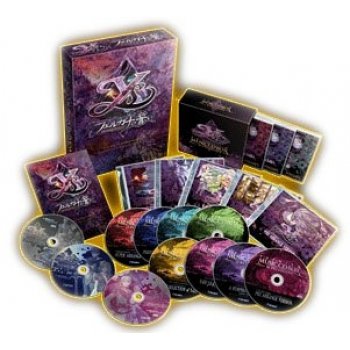
This is the Limited Edition set for the PC version of the game. Huge, ain't it?
The only version that can be ordered up from Falcom nowadays is the “Vista” version of the game, but it works just as well under XP. And thanks to fans, English subs are also available, opening up the story, though you might have to do a little digging to find them. A PSP version has also been created by Falcom for release in mid-2010, although the chances of seeing that over here are just as slim as they were with the original PC version.
The changes have also made Felghana my favorite Ys to date because of its frenetic action, great art direction (Adol sticks to his roots as a detailed sprite), and obnoxiously tough – but fair – bosses. Temporary bonuses, such as strength pluses and experience multipliers, were also awarded whenever enemies were killed and encouraged hit chains. An upgrade system made use of special ore found in dungeons and occasionally dropped by enemies and magic was made an integral part to the gameplay. It wasn't unusual for certain obstacles to force the player to think creatively by using Adol's acquired ability to double-jump coupled with a little magic.

She doesn't need to move around when her attacks do all of the work.
The story was also fleshed out with even more detail going so far as including an in-game encyclopedia providing NPCs with valuable background info and a growing list of monsters. Seeing so much background available for everyone from bosses to the NPCs made the story an impressively well told, and very fun, aspect to the experience especially in conjunction with its expressive use of chibi characters.
Design-wise, backtracking has been largely eliminated here with each area acting as a focused dungeon with a definite start and ending filled with a number of challenges and puzzles. The use of 3D hasn't been a wasted effort, either, with the fixed camera sometimes shifting perspective to impress upon the player the size of certain areas as well as adding a degree of well-fleshed out detail to each scene. The player is also free to run back out of each one and whenever you see a telltale marker offering an opportunity to save, markers that often warn that there's something even worse past it. Like a boss.

Didn't get enough of a whipping the first time? Why not challenge each boss to a timed duel again?
And the music? It fits in amazingly well with the action onscreen. Valestine Castle's remade theme made storming its staircases and wrecking armored knights an entirely new experience in more than what visuals could muster. As for the ending, if there was ever a promise for another adventure done in the language of song and pics, that was it. Oath is a love letter to fans from Falcom in the best way possible and quite possibly the best Ys title for both veterans and newcomers to enjoy.
[embed:http://www.youtube.com/watch?v=vBx3Ok8rj0Q ]
Ys Origin
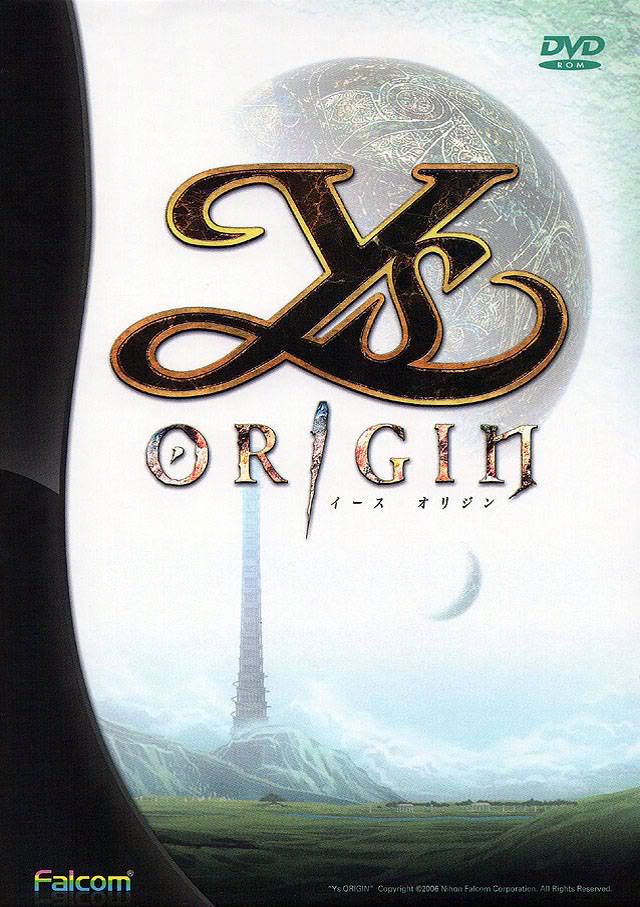
Released in 2006 for PCs in Japan, this was the prequel episode to the entire series taking place seven hundred years prior to Ys I & II back to when Ys was still on the ground. So naturally, players didn't get to play as Adol Christin making it the first in the series to break with tradition. Interestingly enough, he would be added in later as a bonus for fans via an expansion disk.
I haven't had a chance to play this, but I should get it since I've heard that it's a lot like Oath – only with three new characters to pick from – and it also sounds pretty playable without having to understand Japanese. Reading up on more of what the game offers (as well as catching a few videos of captured gameplay), as well as news on a possible patch, it only has me more interested in simply diving into it as it is and worry about the story later.
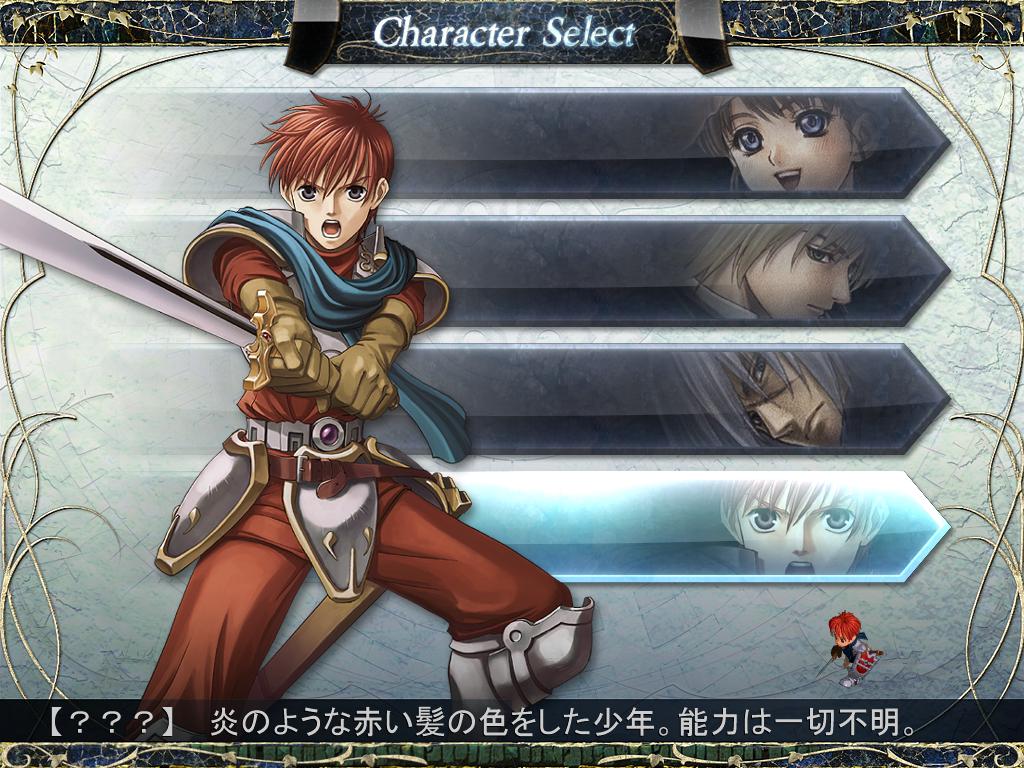
You don't get to play as Adol in the main game, but there are three others to pick from with different fighting styles to make up for him.
Origin comes with three different characters with their stories and skills adding different dimensions to the actual gameplay. Instead of slashing away as Adol would have (although there is a character that seems to be a lot like him), players can pick from another character that favors speed to a magician that attacks with magical bullets. From what I've been able to read up on, each character has their own part to play in unraveling the entire story of the game and the gameplay seems geared towards that.
Another big difference was that the entire game takes place within Darm Tower. It sounds like the game could be boring because of this, but from what I've read so far, it sounds like someone had squeezed multiple dungeons into the building in order to keep it interesting.
The first release of the game would also be accompanied by an expansion disk released later on to owners willing to pay for shipping and handling. It came with an arena mode, alternate version of the main characters, and…Adol Christin as a selectable character in the Arena and Time Attack modes, and two new difficulty levels. The game would also be the last official XP product that Falcom would support.
In 2007, the Vista version was released, although from what I've read, it's essentially the same game only with Vista support meaning that it can still run under XP.
Ys Seven
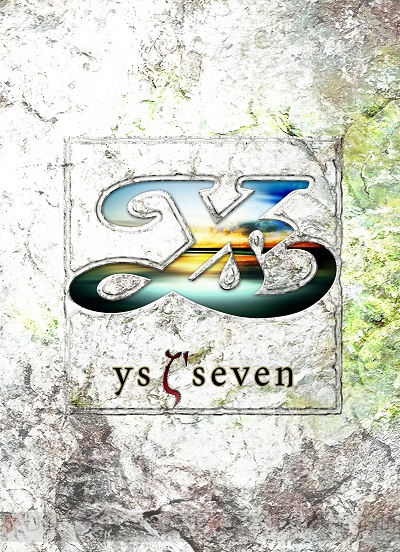
When it comes to picking platforms on which to release their games, it's somewhat hard to try and discern the kind of logic that goes behind each decision. Take, for example, this next Ys game.
Released in 2009 for the PSP, Ys Seven is a whole new adventure featuring Adol Christin, best friend Dogi, and a brand new adventure. Although it only saw a Japanese release, that hasn't stopped fans from importing the game and running it on modded PSPs. And thanks to the same fans, there's enough information out there from sites such as Ancient Land of Ys to help players through its quests without worrying about having to translate anything, though for someone like me that actually wants to know what's going on, it's something of a sacrifice.
I haven't gotten my mitts on this one, but in scouring the 'net, have managed to piece together just what kind of trouble Adol had managed to dig up. In this one, Adol and Dogi find themselves at the rich port of Arthago having apparently escaped the Romun Empire thanks to the intervention of the Dragon Knights' navy. Surprisingly, they make it into port without drowning.
As usual, there are ruins to explore but only after Adol and Dogi dodge being charged as Romun spies. But thanks to the fact that the ruler of Arthago, Duke Kymar, is also an old friend of Ladoc the Pirate (who was also involved in getting Adol to Canaan in Ys VI), he frees Adol and Dogi on the condition that they look into a small matter for him. By now, fans know that what turns out to be a small favor is also an invitation to explore the island and begin another epic tale of monster slaughter and boss level humiliation.
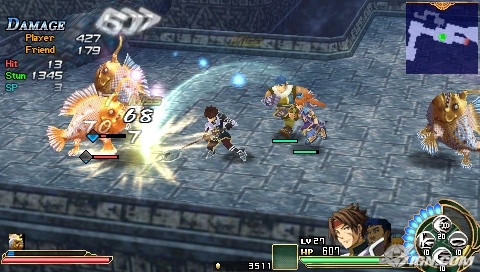
PSP screenshot of the action in Ys Seven
The release came in two flavors: a Limited Edition and a normal version. The first printing of the game came with a Limited Edition Drama CD that has a voice acted episode bridging the events between Ys VI and Ys Seven.
Although the gameplay appears to retain the action-packed approach of Oath and Origin, it has taken the multiple style approach of Origin by giving Adol company during his journey. After he makes a new friend to form a trio, the player can freely switch between characters and use both magic and their weapons for whatever they might encounter. It's as if someone on the team had been playing Marvel vs. Capcom (or Panzer Dragoon Orta with its shifting dragon forms) and wanted to add a little of that in the next Ys.
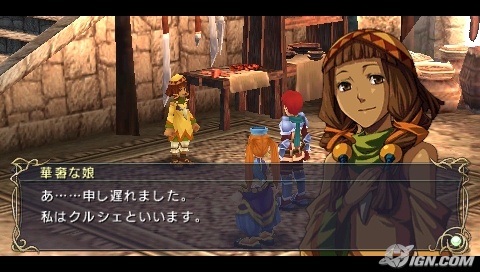
PSP screenshot of Ys Seven
There's also a skill system in place with each weapon having a specific skill that can eventually be upgraded with experience when used which sounds similar to that in Namco Bandai's Tales of Vesperia. Eventually, the skill can also be learned allowing the player to swap between new weapons while retaining the skill. There also seems to be more of a "paper-scissor-rock" mentality to the design of the monster encounters where only certain attacks are particularly damaging compared to others, encouraging the 'switching' mechanic as well as the variety of attacks that the magic system has given each character.
And unlike previous Ys titles, there are also a large number of optional side-quests that can also be undertaken for valuable rewards. They're also event-sensitive, meaning that if you pass a certain part of the main story, you won't be able to do them. Seeking each one out is worth the effort from what I've been able to gather, and thanks to the friendly hardcore fans of Ancient Land of Ys, finding help is as simple as a forum search.
For a more complete look at Ys Seven, you can check out my review of it here on Bitmob.
Media:
[embed:http://www.youtube.com/watch?v=YizVrUcObWA ]
Ys vs. Sora No Kiseki – Alternative Saga

Planned for the PSP and released on July 29, 2010, this Japan-only release boasts a fully voiced cast and an online battle mode supporting up to four players. It will uses Ys Seven's engine with a few tweaks and come in two flavors. From what I can gather, the game will act as a crossover between Ys and Falcom's Sora No Kiseki series featuring characters from both.
The Limited Edition will come with a drama disc that, according to fansite, Endless History, sounds like it will be filled with Sora no Kiseki fanservice in covering events between the third game in that series and the upcoming Legend of Heroes VII.
For those unfamiliar with Sora no Kiseski, it's part of Falcom's long running Legend of Heroes RPG series. It also has a history as rich as Ys, but like many of the series' titles, has largely been Japan-only.


Additional links:
Other YS
Ys Strategy

This game doesn't seem to have anything to do with Falcom other than the name and was developed by a company called Future Creates. It was released for both the Japanese, European, and Australian markets in 2006 avoiding the North American audience entirely. It also sounds like an RTS gone wrong in every way possible aside from forcing players to stay connected to a DRM server to play it.
In digging up what I could on this one, it's an RTS for the DS which shouldn't be too unusual. After all, FF12 Revenant Wings didn't do too badly with that direction along with Rondo of Swords, so tactical strategy isn't too bizarre a challenge for Nintendo's portable. What is bizarre, from what I've been able to gather, is how the game actually plays out.
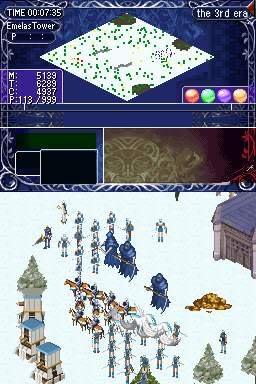
Map at the top, have no idea what the hell is going on on the bottom.
For some reason, you are charged with building up forces and crushing Romun enemies in RTS-style: mine resources, build units and buildings, and head out to kill everything that moves. What appears to be particularly game breaking are the Hero units that can apparently heal themselves whenever they can without penalty before heading back out to devastate the other side. The AI is also apparently as smart as a rock.
It seems to take the player around Ys' world in a fight against the Romun Empire and see the sights that players never got to see outside of Adol's adventures. For what reason is left a mystery since no one seems to have a translation of what the story, which the game is apparently stuffed to the chips with, is all about. I guess it could be fun since there's one review on Metacritic that actually seems to like it, but no link to the actual article to find out why other than the blurb.
Additional links:
Ys I & II Chronicles
This was a remake based on the PC release of Ys I & II Complete and made available only for Japan on the PSP in 2009. It's basically the same game from what I've been able to gather only with a few new tweaks such as four difficulty modes and a number of updated graphics and character portraits.
Then, in a bizarre turn, it was ported back to the PC. Why? I have no idea since the Complete version of the game is still considered the go-to copy to pick up by fans if you want the experience there…which Chronicles is based off of, making this a really strange case of a remake's remake being sold as a new game again. Chronicles' PC version is the horse armor of the Ys series.
Additional links:
Ys: Typing of Ys
This was actually a hidden game within Zwei!!, an action RPG from Falcom exclusively released in Japan in 2002 for Windows PCs, and then later brought out for the PS2 in 2004 and then for the PSP in 2008.
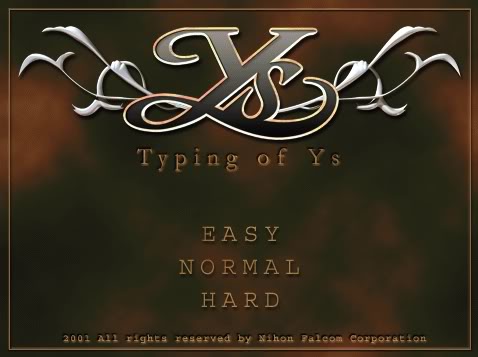
Typing of Ys Title Screen. The fun is about to start!
This is a funky game. It's based off of material from Ys II Complete and is a side-scrolling, typing attack game. Enemies show up with a speech bubble and you have to type what they're saying to defeat them or move on to the next stage. Interestingly, if the enemy is far away, they explode. If you finish typing in their word or phrase and they're in Adol's personal space, Adol slashes at them instead.
Boss attacks are trickier because after typing what's in their speech bubble, blue spheres with letters are shot at Adol and you have to hit the corresponding letters before they do damage, bringing up another speech bubble. Adol has to rinse and repeat this a few times before the boss bites it and with each successive boss, the spheres also increase in shot speed and variety. Some of the bubbles attack in pairs, others stream out, one after another.
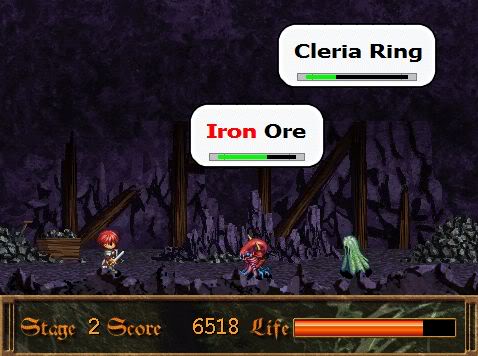
Faster, faster, must type faster!
Later on, more than one enemy will also show up requiring you to pick which to type in first, punctuation and all. It's pretty challenging in the later stages, but it's also quite a fun distraction for when you want to beat on the keyboard instead of monsters for awhile.
Performance is even graded after each stage. Errors, such as missed letters, punctuation, or spacing, are also factored into your score so accuracy is key to getting a good "grade" at the end.
You're not penalized for errors onscreen, but the speed of each enemy as they come at you and the limited health that you have in each stage can make every missed keystroke or fudged letter hurt just as much.
Ys: Book I and Book II Anime series
“Dogi, there's a skull on your head!”

The mantis boss in Ys I in his before shot…

…and after. Adol has a pretty consistent style.
Ys: Book I had seven episodes made for it by Starchild Records (in cooperation with Nihon Falcom) and was released through 1989 to 1991closely following the game's storyline.
Adol was given a speaking part and the series expanded several events such as what Reah and Feena are up to on their own as well as providing a deeper look at the motivations of Dark Fact. It's also nice to see that Adol doesn't have to level up as he hits his stride right from the first episode with godly skill, at least until he meets his first boss, and combat gets pretty graphic in the last few episodes once he's boosted on Cleria. As far as the music goes, fans will recognize a few inspired pieces and a rockin' ending theme is used for the later episodes courtesy of Sound Team JDK.

Here's a familiar face. Ys II ramped up the visuals considerably after the first one.
Ys: Book II also had the same treatment as well as bringing in mega-publisher, Kadokawa-Shoten, and was released through 1992 to 1993, although its story would only take four episodes to tell it. It also looks like it was hit with the Production Staff of Jacked Up Visuals. The animation quality appears much cleaner and more detailed in general and the characters seem much more expressive as a result. Fleah and Lilia's characters quickly make their impressions in the first few minutes and seeing Adol use a blade of grass to whistle Reah's song was an unexpected but welcome surprise.
Unfortunately, the series devolves into a drawn out end-battle with deus ex machina powers, but it's still a fitting finish that could have gone a lot worse. There are more cues in its music that pay homage to the game that it is based on (thanks to Falcom's Sound Team JDK once again) and it simply feels like a big step up from the first episodes.

Doctor Fleah shows a lot more personality here than he does in the actual game.
The short lived series is a big treat for an Ys fan. As an anime fan looking for some fantasy to grind a weekend away with, however, it's certainly decent enough but struggles in holding a candle to other series such as Record of Lodoss War. Anime fans may also recognize a few names for the English dubbed versions of both series, such as anime-everyman, Michael McConnohie.
Unlike several of Falcom's titles, the anime is much easier to get a hold of. Both series have been repackaged as Ys Legacy which you can pick up on Amazon.
Ys: The Call of Solum
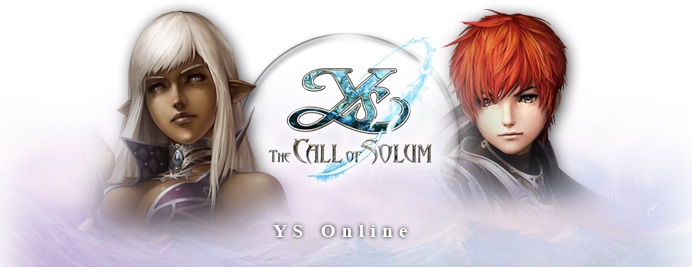
Believe it or not, but there's an online Ys as well, but it bears very little resemblance to the actual games despite the name.
You can't hop online and just start slashing away at everyone you see with impunity. Instead, it's Ys done as an MMORPG which means it's a grinding you will go. At least that's how it looks from the videos that I've watched and it's the impression that I'm getting from what I've been able to find.
It takes place several centuries after the events of Ys VI, so anyone familiar to fans won't be around, although its character creation toolset seems to be capable of creating someone that looks like Adol if you can't be without your favorite protagonist. In this adventure, the Romun Empire is making strides to conquer the world…again…providing ample opportunity for tripping up their plans while uncovering the mysteries of the land.
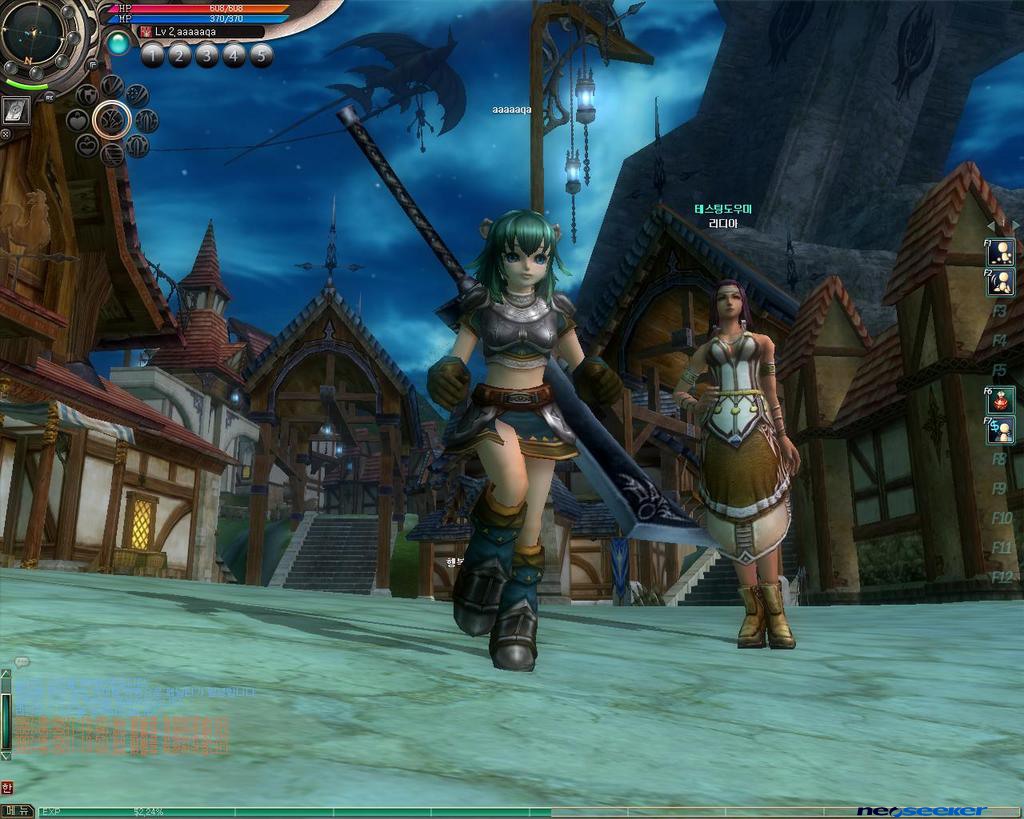
Quick! To the next raiding area!
Three races are offered up: Eresians, Afrocans, and the Kimoans. Eresians are your typical human-types, red hair included, and seem to strike a decent balance between physical combat and the magical arts. Afrocans resemble bigger versions of Eresians and come off as the heavy hitters of the world, more at home with battle axes than in peacemaking. And the diminutive Kimoans are the most agile (and elvish-like) of the three races and are best suited to classes that rely on their unique abilities, such as crafting and archery.
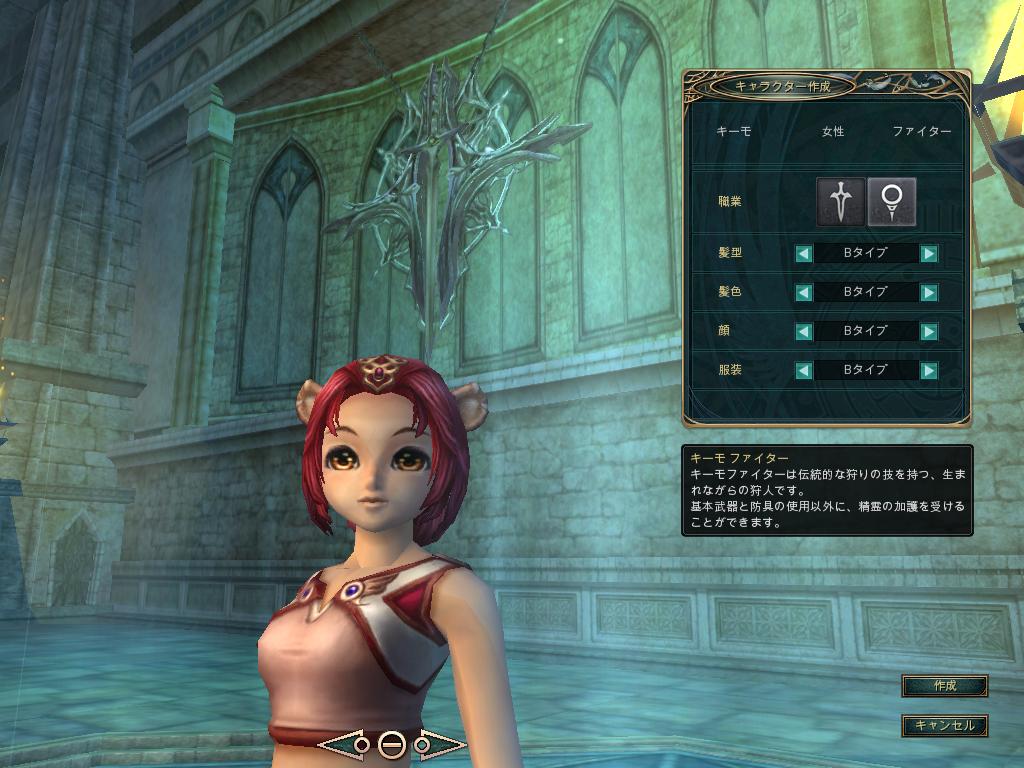
Aside from gender, you can alter a few cosmetic characteristics to customize your look online.
The remaining info on what actually happened to its release was pretty convoluted. What I do know is that it's still out in South Korea (where it came out in 2007) and Japan and is free to play, courtesy of South Korean developer, CJ Internet, which created the game for Falcom. It uses microtransactions to generate revenue and it's apparently doing okay in South Korea. It's also supposed to be out in Europe, but I could find even less hard information on how that went.
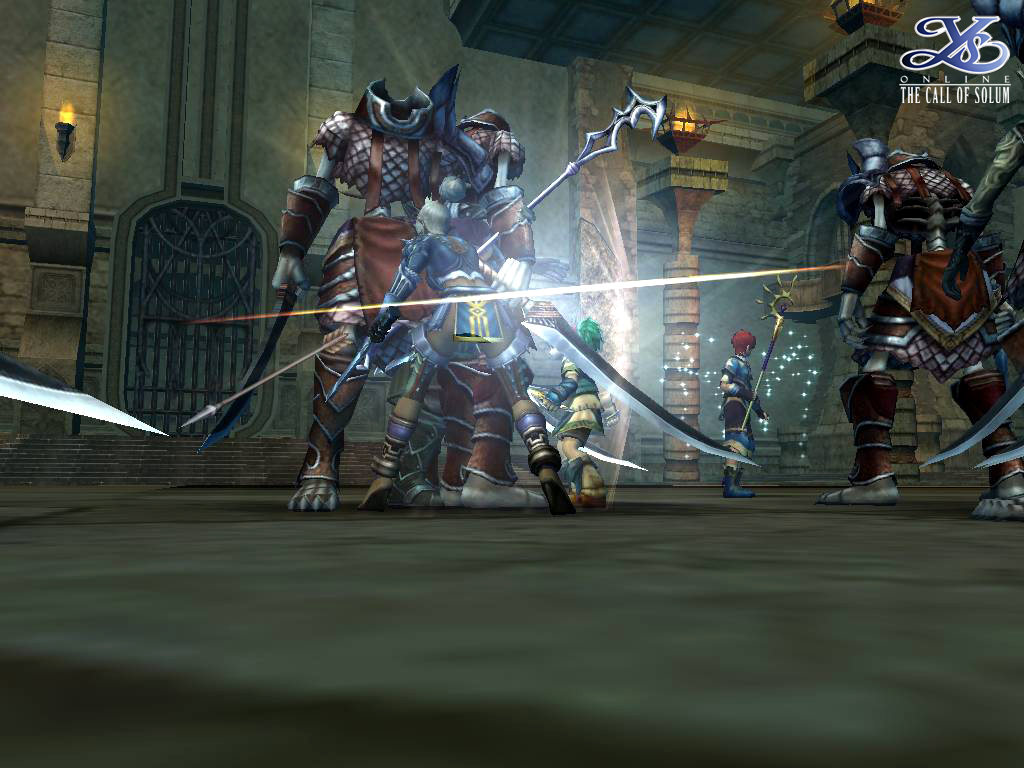
It's an MMO, so you knew there had to be lots of fighting ("grinding").
There may be a few good reasons for that. One being that IPs from Asia and North America were apparently being blocked by the servers in Europe when held its open beta there mid-2009, meaning that no one from outside that region could get in unless they did a little creative routing to get around it. The other is that it didn't last very long over there when the beta started before shutting down on November 30th in the same year.
And not only did the game go away, but Key To Play (the portal responsible for bringing Ys Online and Priston Tale II to Europe) had also vanished at around the same time. It was especially worse for fans of Falcom's Sound Team JDK since the European site offered a selection of track from the game as a free download before going down.
With that, it's probably a safe bet that any hope for the game to come over to North America is dead unless you can read the Korean or Japanese. But at least you can still buy power leveling services for it along with gold if you ever get into the game.
Additional links:
- Ys Online Japan
-
Ys Online South Korea
-
Ys Online – The Call of Solum's entry on MMORPG
-
Ys Online entry on MMOSITE
How to Order Ys
There are several ways to get your Ys fix, but not every Ys title is easy to get a hold of. Unlike Ys' early history of multi-platform releases across a wide spectrum of hardware, the most recent games and remakes have been spread out in a much narrower field and not every Ys has been given a facelift.
For example, Ys IV and V, in particular, are missing from that marching order of remade releases on the PC. However, Taito's PS2 renditions of Ys III, IV, and V may be easier to find if not exactly prove to be the best versions in comparison to their original incarnations (or, in Ys III's case, to Falcom's own remake with The Oath in Felghana). Even if you get a hold of Taito's remakes, you'll need a Japanese PS2 or one that has been modded to play them.
As a more recent example, the newest Ys, Ys Seven, is available only on the PSP with no plans for it to appear on other platforms or as a translated game for the West at the time of this writing. It hasn't stopped a dedicated fanbase from translating the quests and providing walkthroughs for it, however, allowing players to enjoy its fast action, fabulous music, and the crisp visuals. The story, however, will benefit only those that can actually read kanji although fans have also written their own summaries as to what is actually going on if not offer a play-by-play accounting of every event as they occur.
But all is not lost. It is also thanks to the same fans that there is quite a bit of documentation available to help out, such as how to order directly from Falcom and support their efforts. Ancient Land of Ys has a walkthough on how to set up your order thanks to a helpful post.
My own experience differed a bit when it seemed that they didn't get back to me. A week or so later, I received an e-mail from Nihon Falcom that apologized for mistaking my e-mail for junk and then replied with the info I needed to order direct from them. Now that's service.
I started off with a simple question as to whether I could order The Oath of Felghana from them, and after a little email mix up, they asked for the following:
*Shipping
recipient name:
shipping address:
telephone number:
*Credit card information
credit card kind:[ JCB.UC.VISA.Master.AMEX.NICOS.DC ]
credit card owner's name:
credit card owner's address:[ if different from shipping address ]
credit card number(sixteens digits):
credit card term of validity(year/month):
If you are ok, we think we would like to accept your order.
We are waiting for your reply.
Thank you
The information is pretty straightforward, although I didn't feel comfortable in sending my CC number in an unsecured e-mail. Fortunately, there are a few ways to get around this. What I did was to use a temporary CC number with a pre-set limit. It can be used only once and was somewhat easy to set up once I found the feature, so you might want to check to see if your credit card offers a similar service.
So I sent that after getting the total from them to know what I should roughly set the limit at.
After filling out the rest of the information and sending it back, Falcom sent me a confirmation email.
The game was sent via EMS but was well packaged and protected. It took about a week and a half to get to me and honestly, I thought it would have taken longer. But it was a lot easier than I thought it would be. The link above to the method shown by Ancient Land of Ys should also work just as well and even guide you to getting anything else you might want direct from Falcom.
As for emulation, that might be the only way that certain titles can be experienced by today's audience since the actual hardware and, in Ys II Special's case, software may no longer be available commercially.
Additional links:
So why should I bother with Ys?
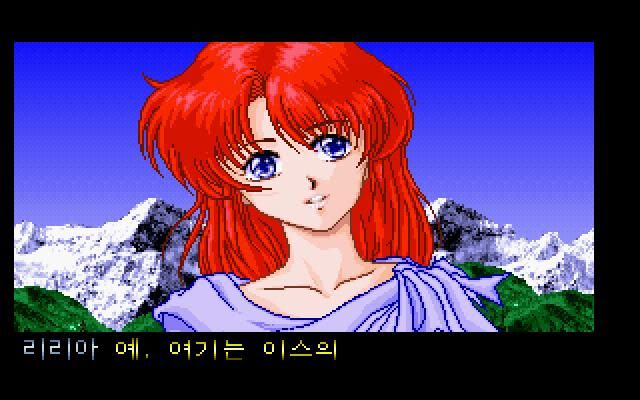
Why do you want to see her cry?
Why should you… But I just…
Alright, you want a serious answer. For me, Ys has been an exciting journey since getting a taste of it with the SNES version. It's simple, has a straightforward story to it with decent characters, and is simply fun all around. I'm always hoping that someone will port their next title over to the West, or that someone has finally finished a fansub project for their most recent titles.
The gameplay may not have the best looking CG or sport the latest trends in hack 'n slash, but like its music, has a very specific style to it that has retained its appeal over the last two decades. Falcom seems to have recognized that and has done little to alter the formula that their fans seem to love, grinding out the rough spots when needed and tweaking it in just the right places with each new chapter. Or completely re-inventing a chapter from scratch as they did with Felghana.
Their changes might not always pan out as well as some of their fans have hoped, too, but I think they've had a lot more hits than misses in that department. Especially when they take control of a project themselves instead of licensing it out to others. Ys has firmly held onto its own special niche thanks to sticking to its own basics and has never been about trumping the competition in the same way that has made it a life-and-death struggle for much larger studios.
Quite possibly because it does firmly stick to its old school design principles, the franchise can come off as either sadly nostalgic, quickly frustrating, or even boring to other gamers weaned on today's next-gen milkshakes. When compared to its peers within the genre, its hard to ignore where it can come up short. It's not unusual to run across reviews that slot Ys for not keeping up with the times. But at the same time, not everyone loves cheeseburgers, either.

Ys might be too much for some tastes, even when lathered in the good kind of cheese.
More importantly, try it for yourself. Track down a copy of Ys VI or import a PC version of The Oath in Felghana and give those a shot to see if there's something for you. Or do a bit more research on your own by watching a few more videos or reading up on other sources. Then take the plunge if you want to try something a little different.
Because if you love taking bite-sized morsels of action, have a soft spot for anime artwork, enjoy kicking back a shot-sized serving of storytelling, and can't get enough of speedy special attacks, hardcore bosses, and J-rock playing sweet violin with your reflexes, then Adol the Red is waiting to take you on an adventure you may not forget.
Just be sure that you're the one sailing the boat.
Additional Sources
-
Nihon Falcom's Homepage
The home of Adol the Red and the land of Ys…along with lots of other great stuff! -
Ancient Land of Ys
Home to hardcore fans of the series, it's a forum filled with friendly debates and news on everything Ys. -
Hardcore Gaming 101's Ys Overview
Run by hardcore gamer and journalist, Kurt Kalata, he gives an overview on the series filled with a gallery of screenshots and specific information on many of the platform versions covered. An incredible resource on retro-gaming goodness. -
RPGFan
A site dedicated to RPGs (focusing primarily on JRPGs) complete with an extensive soundtrack review section filled with plenty of Falcom Sound Team JDK history. -
Sega-16
A huge and well organized fan-site dedicated to Sega's old-school classics. -
Endless History
A site dedicated to collecting news on the latest games from Nihon Falcom. With as much breaking news as there is reported here, it comes off as a Western outpost for the latest news out of Falcom. -
DOSBox
It's DOSBox! Need to play Ys II Special? Here's one way to do it as well as keep your older PC games alive. Awesome! Some technical know-how is needed to tweak it for certain games, but it's constantly updated.
General Terminology
IIGS – Released by Apple in 1986, the “GS” stood for Graphics and Sound. Ys I was released for the system in 1989.
DOS – Short for Disk Operating System, this was an inclusive term for several software versions with the same functionality that ran IBM PC compatibles during the eighties and the nineties. MS-DOS, for example, was the Microsoft flavored DOS juggernaut that eventually dominated the market. Ys I was released for DOS in 1988.
DOSBox – This is an emulator that mimics MS-DOS and is freeware. Very useful for running older games on newer OSes. You know, other games thans Ys II Special.
Emulation (software) – The means by which certain programs can be run on hardware that they were not specifically designed for. For example, certain PS3 models utilized emulation software to enable backwards compatibility with PS2.
Famicom – Also known as the Nintendo Entertainment System (NES) outside of Japan, Ys I was released for it in 1988.
Master System – Also known as the Sega Master System (SMS), Ys I was released for it in 1988.
FM-7 – This was the Fujitsu Micro 7 and Fujitsu's first foray into the PC market in Japan. It was among the five initial platforms that Ys I was released for in 1987.
Microsoft Windows – A generic term used to encapsulate Microsoft's Windows platform releases. If you're running XP, for example, you've got Microsoft Windows. Ys I & II Complete (2001), Ys VI: Ark of Napishtim (2003), Ys: The Oath in Felghana (2005), and Ys Origin (2006) would all see Japan-only releases (with the exception of Napishtim's port by Konami) on Windows. Interestingly, all of these releases were handled exclusively by Falcom, hearkening back to their PC roots. Ys Online: The Call of Solum was also released for the platform in 2007, but was not developed exclusively by Falcom and instead by CJ Internet, a South Korean company focused on online gaming.
MSX – An early attempt at providing a standardized home computer architecture released in 1983, it proved to be a fairly popular PC in Japan and Europe. The MSX2, the second generation of the hardware, was among the five initial platforms that Ys I was released for in 1987.
Nintendo DS – A handheld console released in 2004 by Nintendo. Ys: The Vanished Omen and Ys II: Ancient Ys Vanished DS were Japan-only releases that appeared it in 2008. Ys Strategy also saw a Japan-only release for the handheld in 2006.
PC-8801 – Otherwise known as the PC-88, it was a developed and released by the NEC Corporation exclusively for Japan where it proved to be quite popular. It was among the five initial platforms that Ys I was released for in 1987.
PC-9801 – Also known as the PC-98, the first model was released in 1982 by the NEC Corporation. It was among the five initial platforms that Ys I was released for in 1987.
Playstation 2 – Otherwise abbreviated as the PS2, it was released in 2000 by Sony and would be the home of Taito's licensed remakes of Ys III: Wanderers from Ys – Ys V: Mask of the Sun, A New Theory. Konami's port of Ys VI: Ark of Napishtim would also be released for the platform. Ys I & II Eternal Story would also see a Japan-only release for the PS2 in 2003.
PSP – The Playstation Portable by Sony. It would become the recipient of Ys I & II Chronicles (2009) and the exclusive home of Ys Seven (2009). Ys vs. Sora no Kiseki – Alternative Saga is also slated for release on it in 2010.
RPG – Short for “rocket propelled grenade”, the most widely used version of which was developed by the former Soviet Union as the RPG-7. It and variants of the weapon are often referred to as a noob weapon in online matches. Can also stand for role-playing game.
Sharp X68000 – A Japan-only home PC released in 1987. It was among the three initial systems that Ys III: Wanderers from Ys would be released for 1989.
Sega Genesis – A 16-bit system known as the Sega Mega Drive in Japan. It was released in Japan in 1988 and came over to the States in 1989. Ys III: Wanderers from Ys would be released for it in 1991.
Super Famicom – A 16-bit system known as the Super Nintendo System (SNES) outside of Japan, YS III: Wanderers form Ys would be released for it in 1991.
TurboGrafx-16 – A game console released by the NEC Corporation for Japan in 1987 and the United States in 1989. It was known in Japan as the PC Engine. It utilized memory cards instead of cartridges which were the dominant form of console media at the time. It would eventually have a CD add-on which Ys Book I & II was eventually released for in 1992, Ys III in 1991, and Ys IV: The Dawn of Ys in 1994.
X1 – Developed by Sharp and initially released in 1982, it wasn't as popular as NEC's PCs or the MSX. It was among the five initial platforms that Ys I was released for in 1987.
Timeline
All releases are assumed to be Japan-only unless otherwise noted. This isn't a comprehensive list because of a few differences between sources (I made my best guess on those). So please consider it more of a rough sketch of Ys' major releases over the years that's probably bound to change.
1981
Nihon Falcom is founded by Masayuki Kato
1987
(6/21) Ys I released for the NEC PC-88
(6/26) Ys I released for the X1
(8/28) Ys I released for PC-98
(10/8) Ys I released for the FM-7 platform with improvements to the final boss theme
(12/10) Ys I released for the MSX2 with cleaner NPC sprites
1988
(4/22) Ys II released for PC-88 with 4-bit color. Was also released for the PC-98, FM-7, X1
(7/15) Ys II released for the MSX2. Although with slightly lower quality graphics and sound, load times were improved.
(8/26) Ys I released for the Famicom. Considered “Alternate Dimension Ys” and due to hardware issues, map layouts were altered and the final boss was easier.
(10/15) Ys I released for the SMS in Japan (Sega Mark III) with some map changes.
1989
Ys I & II released for DOS, IIGS, PC-98, and X68000 platforms
(7/21) Ys III released for the PC-88
(12/21) Ys I & II released as a compilation for the PC Engine
1990
Ys I & II compilation released for the TG-16 in North America
(5/25) Ys II released for the Famicom
1991
Ys III Wanderers from Ys released in North America on the TG-16 and the Sega Genesis
(January) Ys III released for the SNES in North America
(3/22) Ys III Wanderers from Ys released on the PCE
(6/21) Ys III released for the Super Famicom (SFC)
(9/27) Ys III released for the Famicom
(11/1) Ys III released for the Sega Mega Drive
1993
(11/16) Ys IV: Mask of the Sun released for the SFC
(12/22) Ys IV: Dawn of Ys released for PC Engine
1995
(12/29) Ys V released for the SFC
1996
(3/22) Ys V Expert released for the SFC
1997
(11/6) Ys I released as part of the Falcom Classics collection on the Saturn
1998
(4/29) Ys I Eternal released for Windows
(10/29) Ys II released as part of Falcom Classics II on the Saturn
2000
(7/6) Ys II Eternal released for Windows
2001
(6.28) Ys I & II Complete released for Windows
2003
(8/7) Ys I & II Eternal story released for the PS2; based off of the Complete version for the Windows with a few tweaks
(9/27) Ys VI released for the Windows
2005
(2/22) Ys VI released for the PS2 in North America
(3/10) Ys VI released for the PS2
(3/24) Ys III remake, Limited Edition, released for the PS2 by Taito
(3/24) Ys III (normal edition) released for the PS2 by Taito
(5/26) Ys IV remake released for the PS2
(9/16) Ys VI released for the PS2 in Europe
2006
(1/19) Ys VI released for the PSP
(2/28) Ys VI released for the PSP in North America
(3/23) Ys Strategy released for the Nintendo DS
(3/29) Ys V remake released by Taito for the PS2
(9/29) Ys VI released for the PSP in Europe
(10/6) Ys VI released for the PSP in Australia
(12/7) Ys Strategy released for the Nintendo DS in Europe and Australia
(12/21) Ys Origin released for Windows
2007
Ys Online: The Call of Solum released in South Korea by CJ Internet
(3/10) Ys VI released with Vista support for the Windows
(8/25) Ys I & II compilation released on Wii Virtual Console for North America
(9/5) Ys I & II compilation released on Wii Virtual Console for Europe
(10/16) Ys I & II compilation released on Wii Virtual Console
2008
(3/20) Ys I DS and Ys II DS are released as a revision of Ys Eternal
2009
Ys Online opens beta in Europe and closes operations 11/29 in the same year.
(2/24) Legacy of Ys Book I & II released in North America for the Nintendo DS by Atlus
(9/17) Ys Seven is released for the PSP in Japan
(12/3) Ys: The Ark of Napishtim (Konami the Best) released for PSP
(12/24) Ys I & II Chronicles released for Windows
(12/25) Ys Online (Premium Package) released for Windows
2010
(3/18) Ys I & II Seven Set released for the PSP
(7/29) Ys vs. Sora no Kiseki: Alternative Saga for the PSP
(8/17) Ys Seven released for the PSP in NA
2011
(9/27) Fan sub experts at Figli di Gaucci Productions — Doppiapunta, Deuce, and Gho — release the English patch for the then Japanese-only Ys Origin
2012
(5/29) Ys Origin released on Steam by XSEED
Sources:
-
GameFAQs
-
Wikipedia
- Legacy of Ys' manual from Atlus
-
I Figli di Gaucci Productions
